Open Office: une collection de textes, podcasts, entretiens et ressources qui documentent Freedom of Sleep.
Open Office: a collection of texts, podcasts, interviews and ressources that document Freedom of Sleep.
Exhibition presentation / documentation
Videos
Vidéo d'introduction (1 min, FR/ENG)
Vidéo de présentation (17 min, FR, english subtitles)
Entretien avec la commissaire d'exposition (3 min, FR)
Captations de la journée d'étude Station 19 : La nuit, de l'insomnie au rêve éveillé : un espace-temps de subversion ? de l'Institut d'Art Contemporain de Villeurbanne (FR, à droite)
Exhibition Trailer (1min, FR/ENG)
Presentation video with artist interviews (17 min, FR, english subtitles)
Curator interview (3 min, FR)
Recordings from the Brain Space Laboratory study day Station 19: The night, from insomnia to waking dreams: a space-time of subversion? (FR only)
Video documentation of performances One Day (FR)
Vues d'exposition / Exhibition views
Photographs
All photographs, credit: Martin Argyroglo
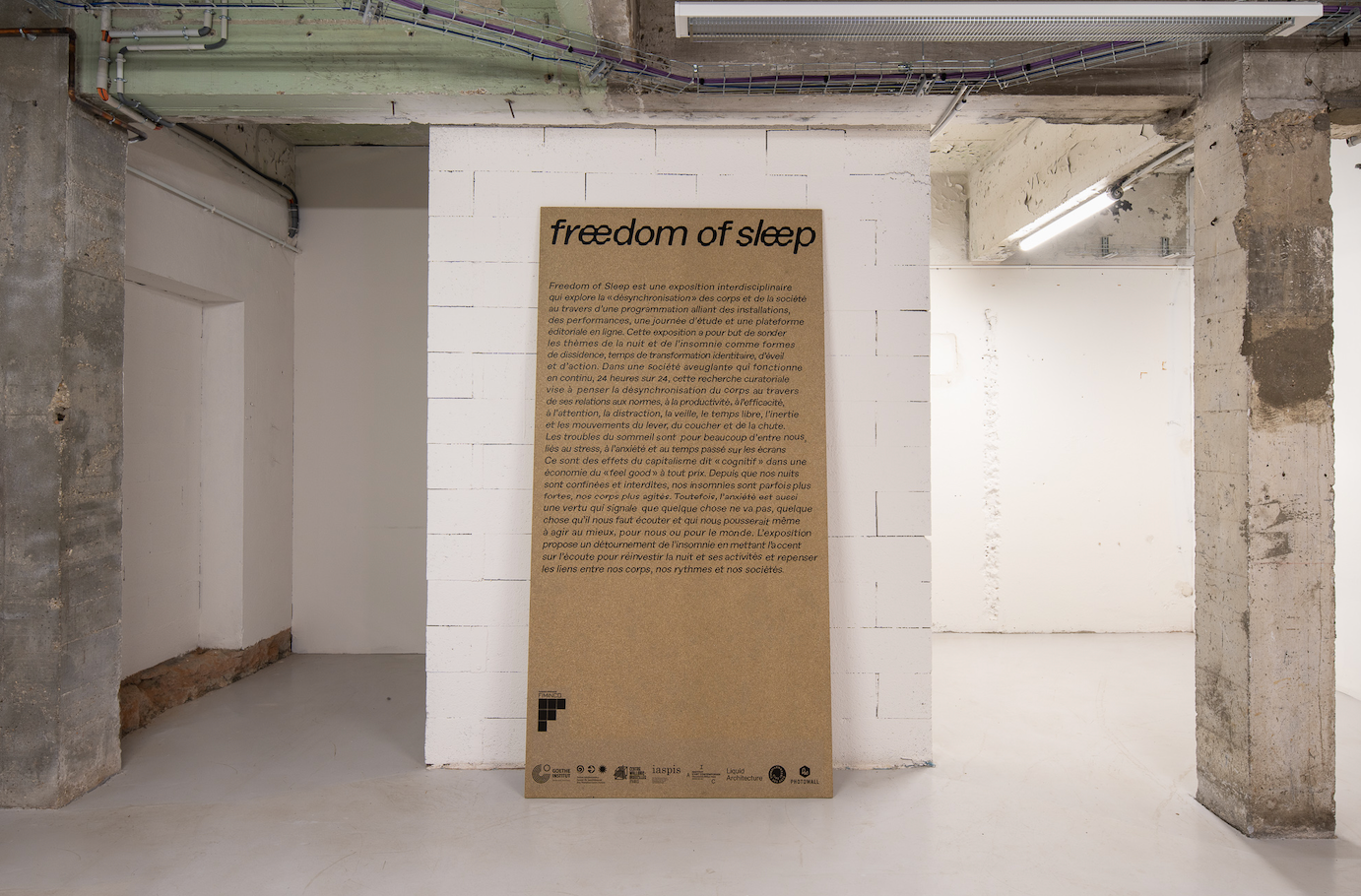
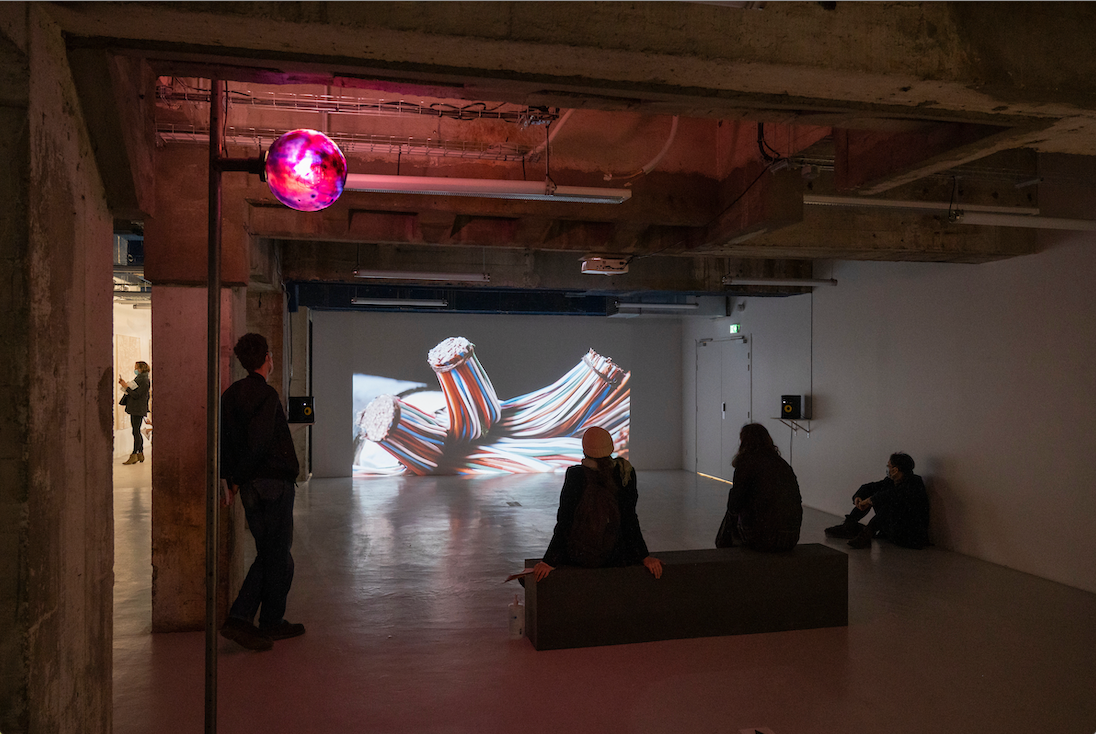
Sonia Leber & David Chesworth, Mission Crimps, 2021, 4k UHD video, 7’17 min.
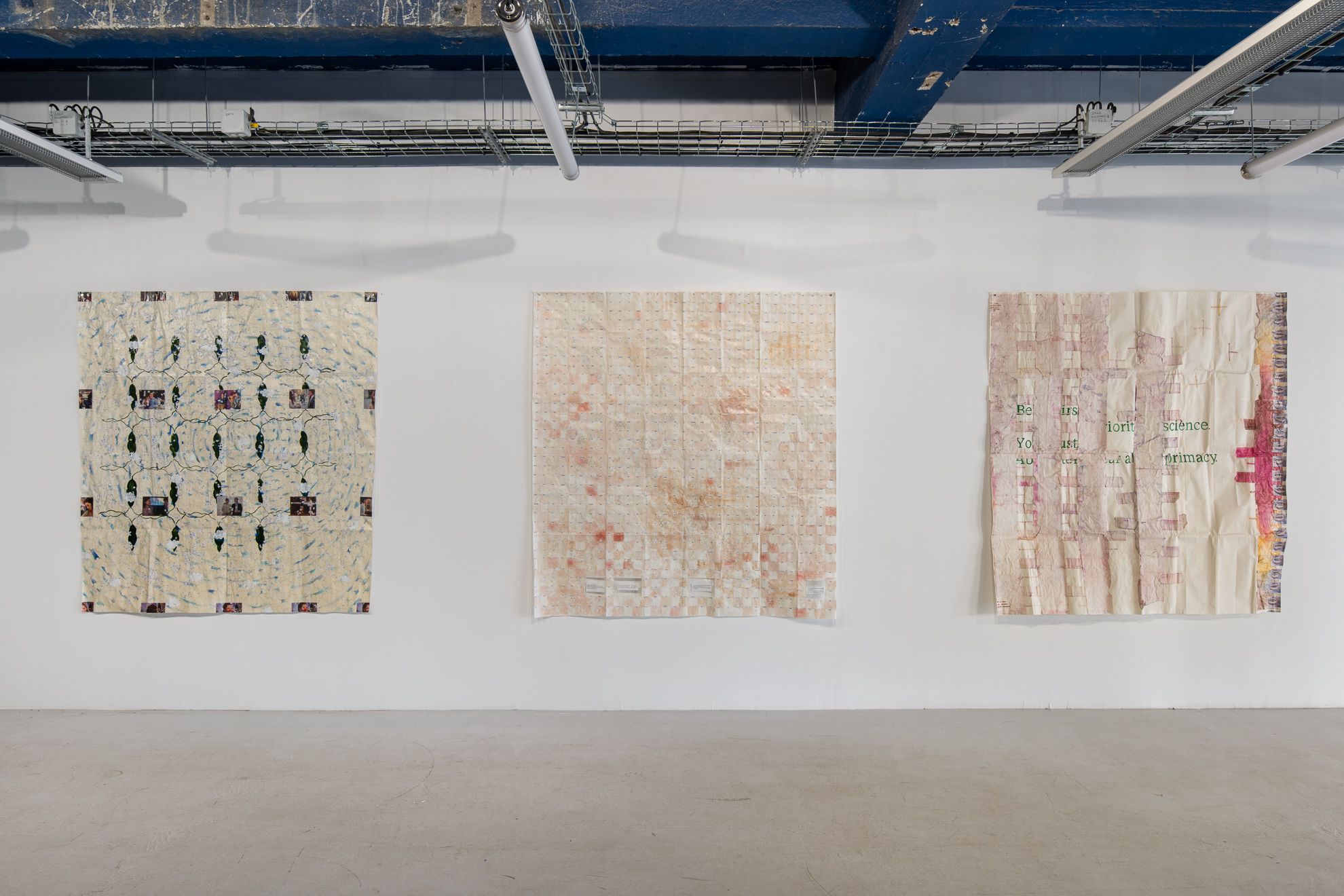
Aodhan Madden & Rosie Isaac, Brain Blankets, 2021, matériaux mixtes sur papier, 200 x 200 cm.
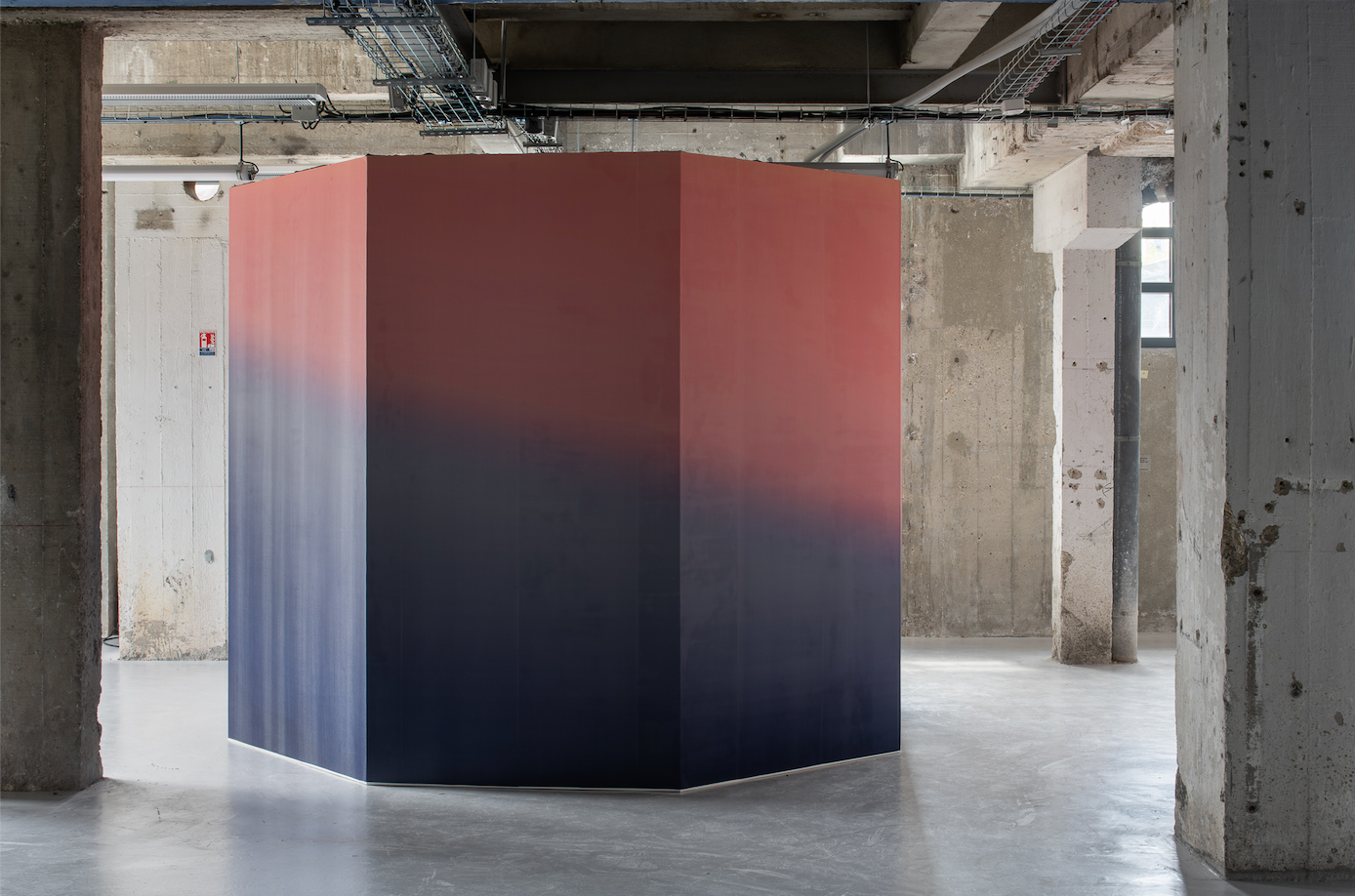
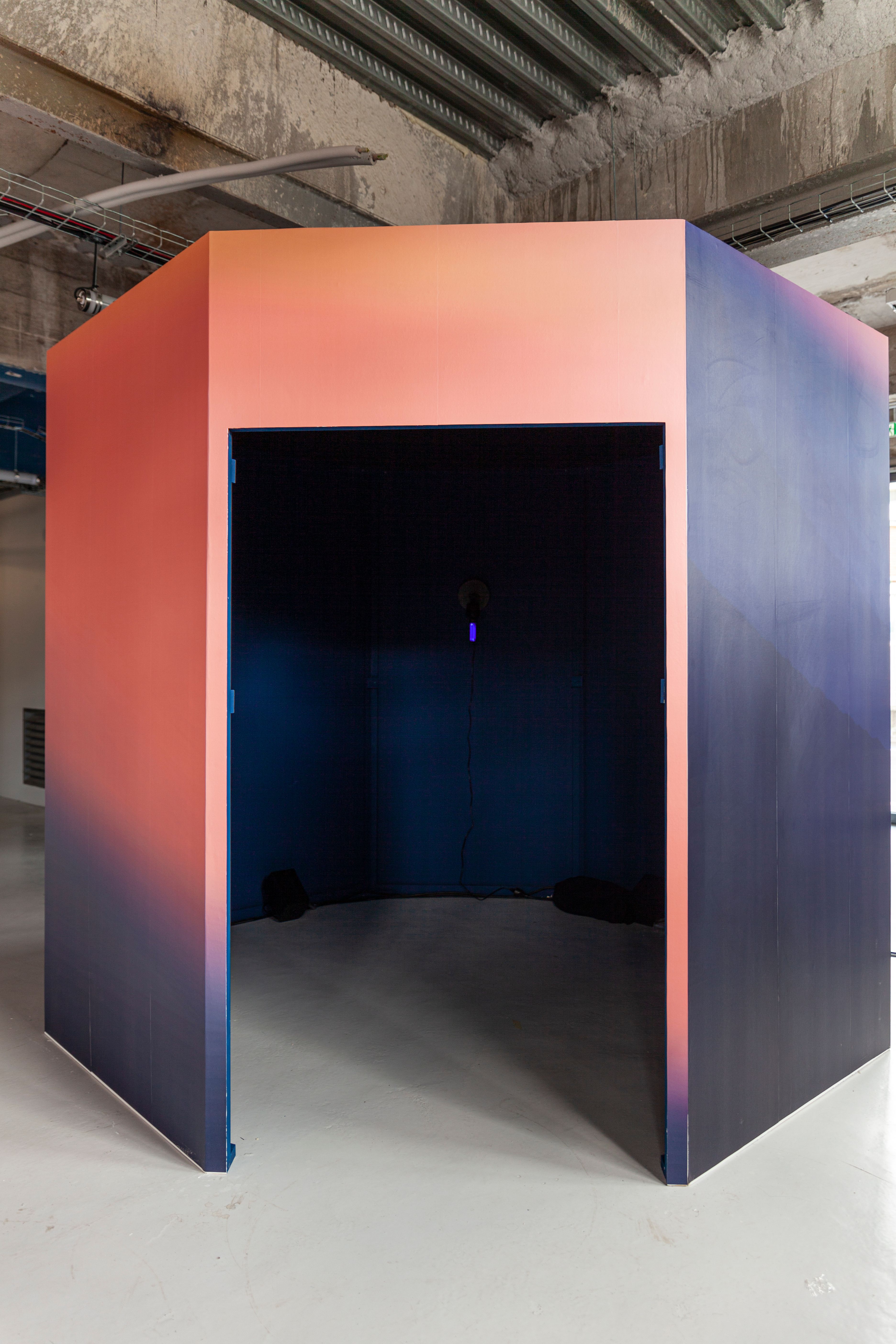
Katja Aglert, Penumbra Tales, 2021, 4-channel sound installation, black light, plywood octagonal room, wallpaper, 240 x 300 x 300 cm. Sound design: Matthieu Gasnier.
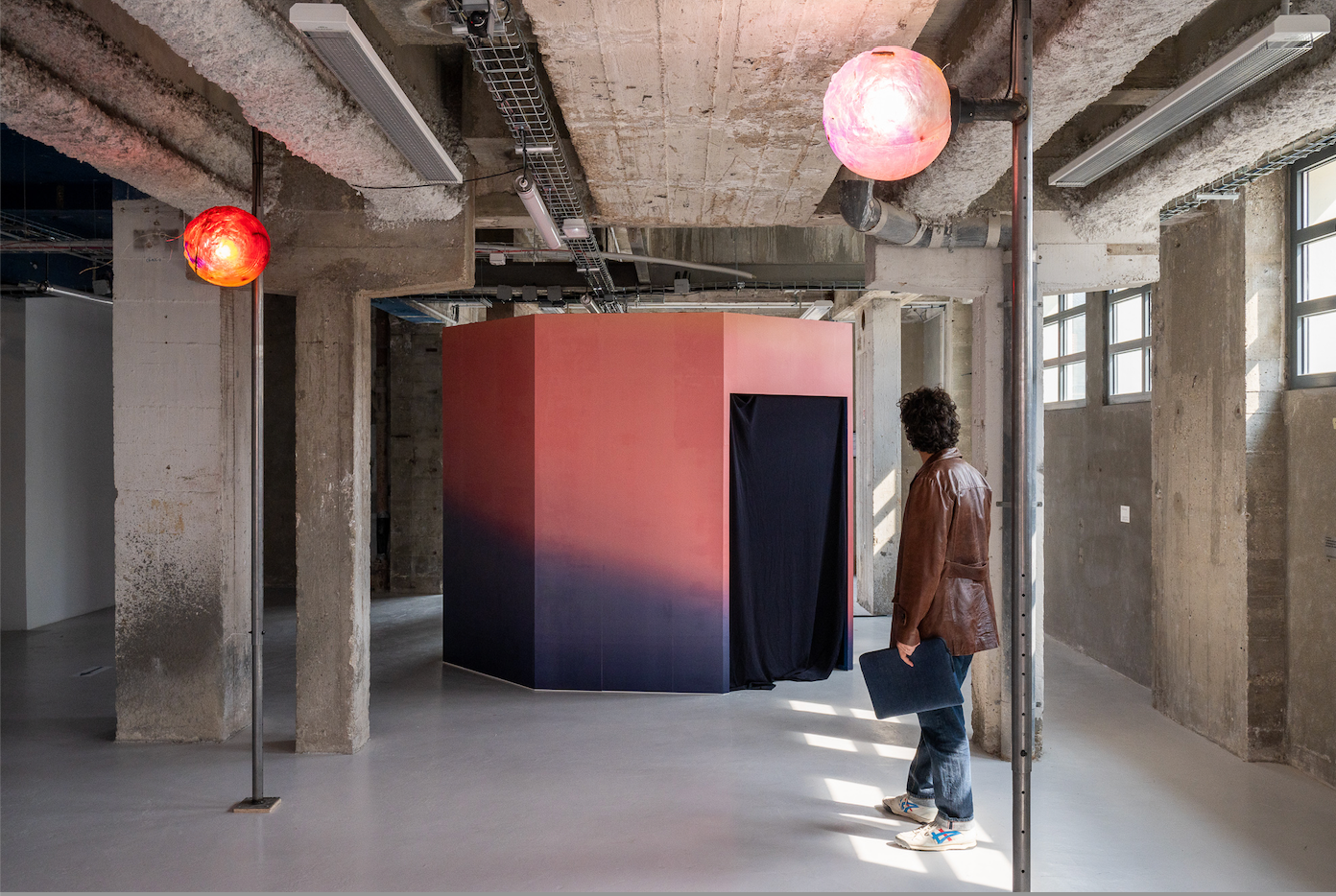
Evita Vasiljeva, Seven reasons why you should make time for the sunsets I–IV, 2020 Soap, flies from Latvia, plastic, metal, pigments, paper, wires, lamp, variable dimensions
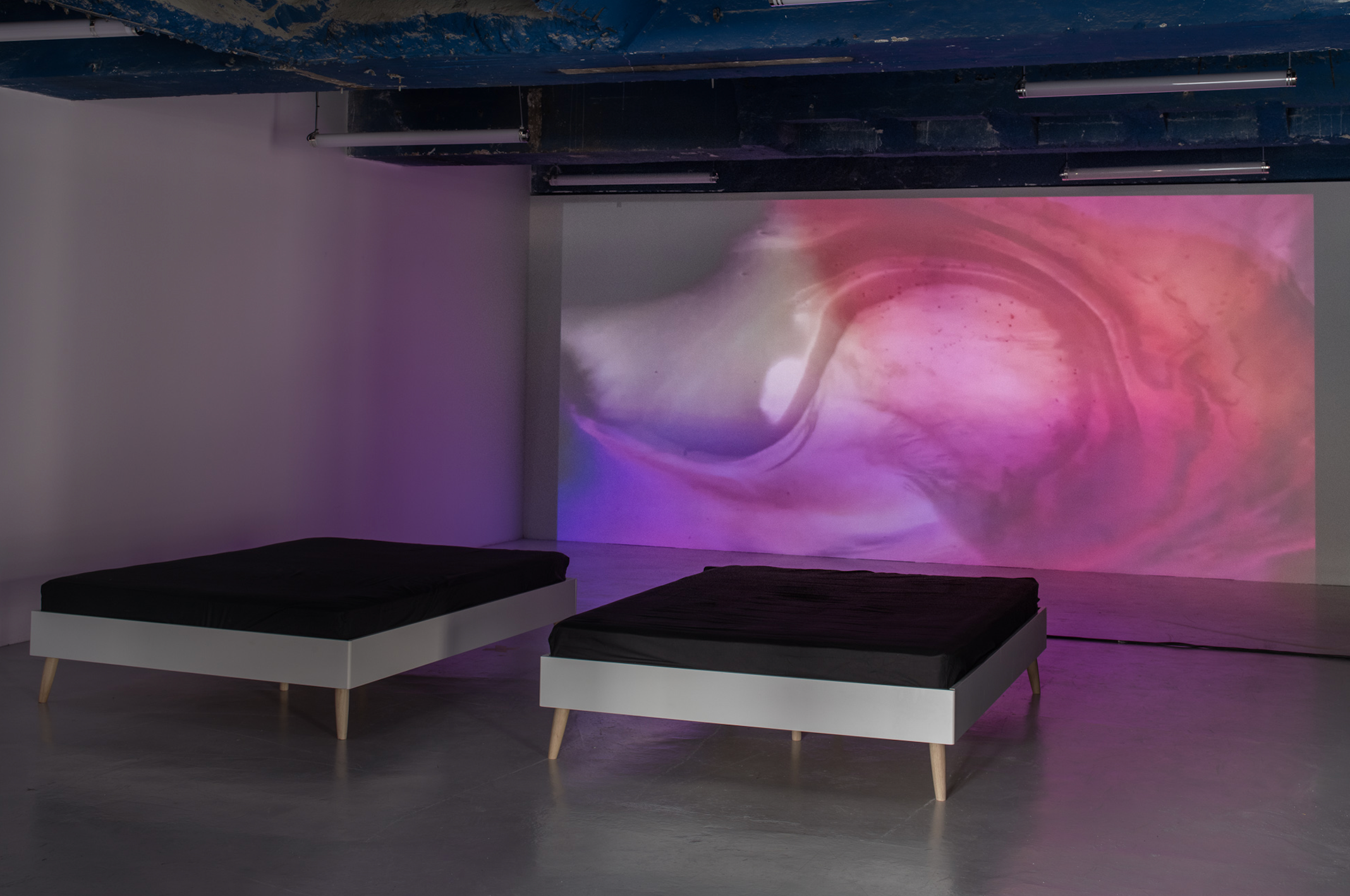
Danilo Correale, No More Sleep No More, 2015, HD video, beds, 240 min
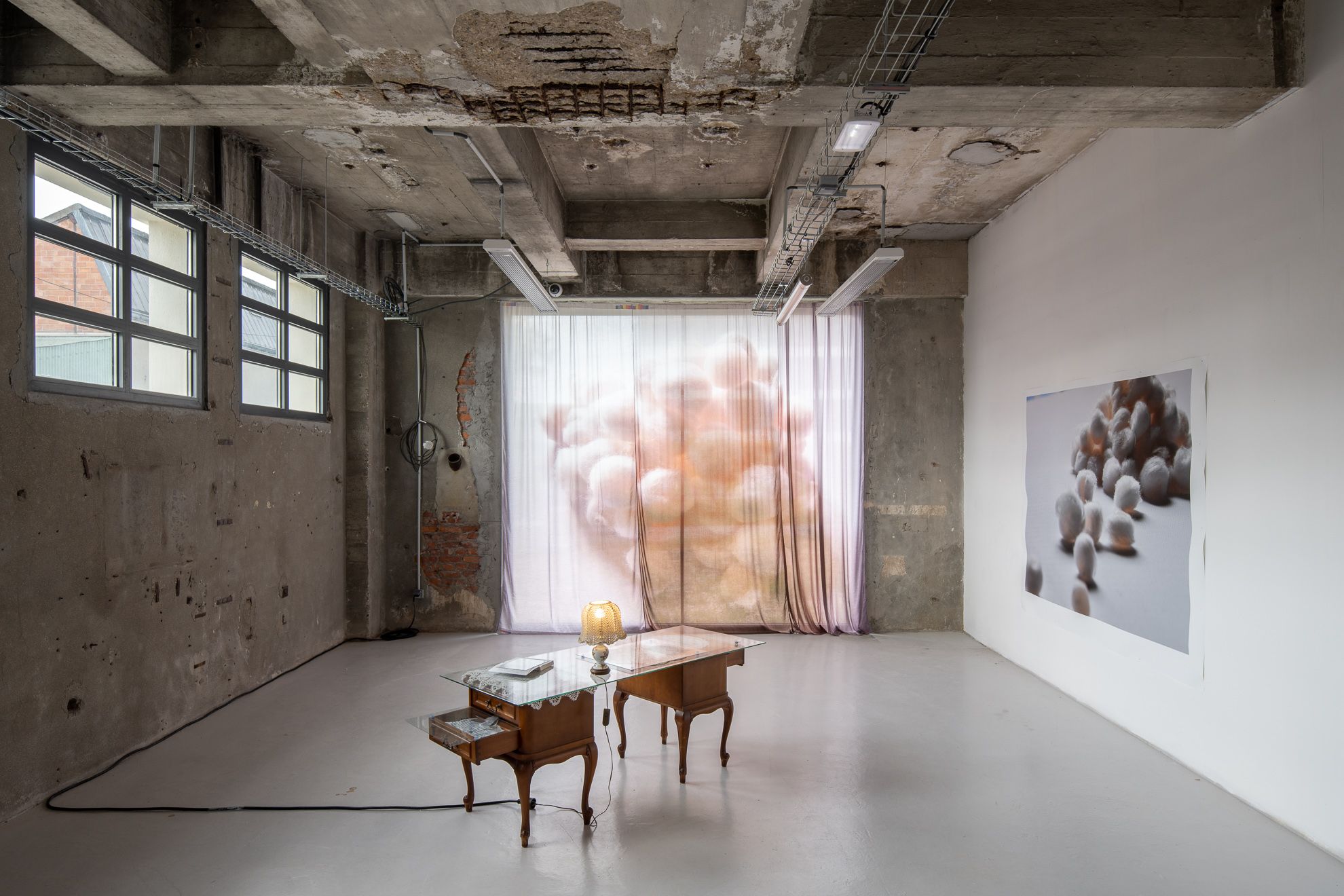
Farah Khelil, Point de vue, point d'écoute (Nuit blanche), 2010-2021, photograph printed on veiling, 435 x 310 cm ; photograph on paper 162,6 x 216,8 cm. Notes de chevet, 2021, bedside tables, glass, photographs, earplugs, silkscreen on doilies, 60 x 100 x 150 cm.
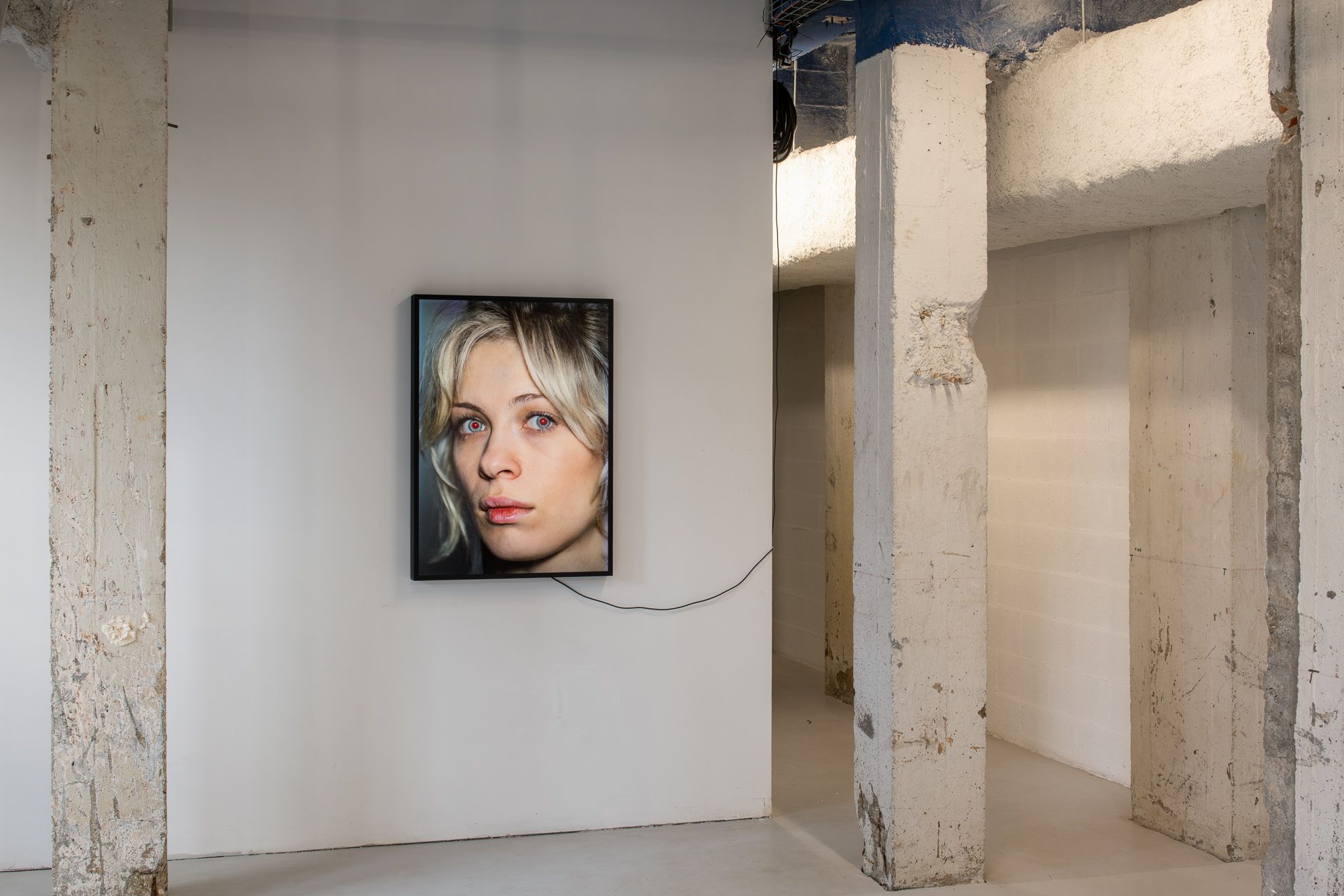
Alona Rodeh, Girl (From the Safe and Sound Posters series), 2015, C-Print mounted onPlexiglass, LED lightbox, 100 x 70 x 8 cm.
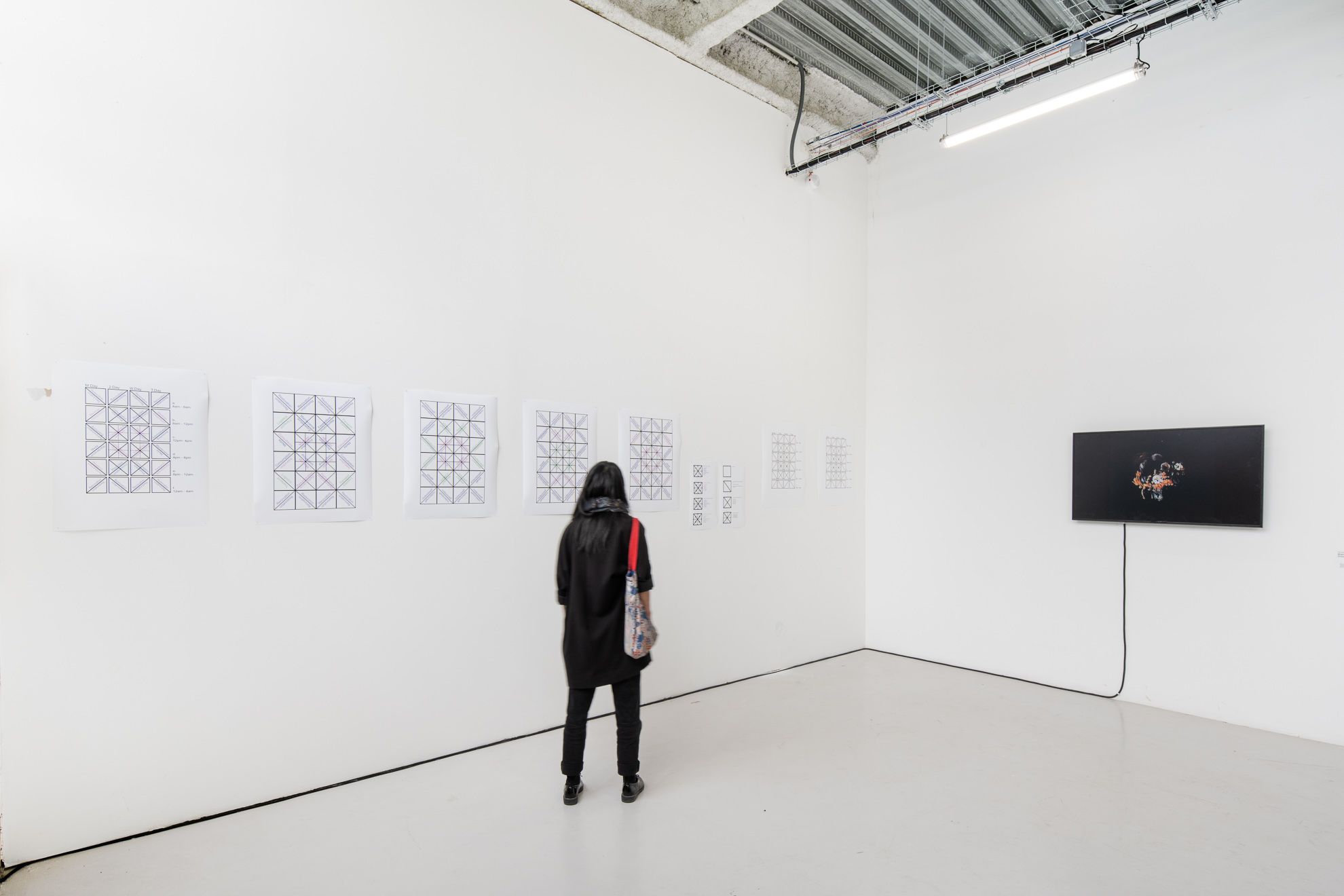
Debris Facility Pty Ldt, Schedule, 2021, prints on paper and 12 audio pieces, 10 sec.
Tom Smith & Jon Watts, Waking Life: The Dreamwork Model, 2020, HD Video, 17'38 min.


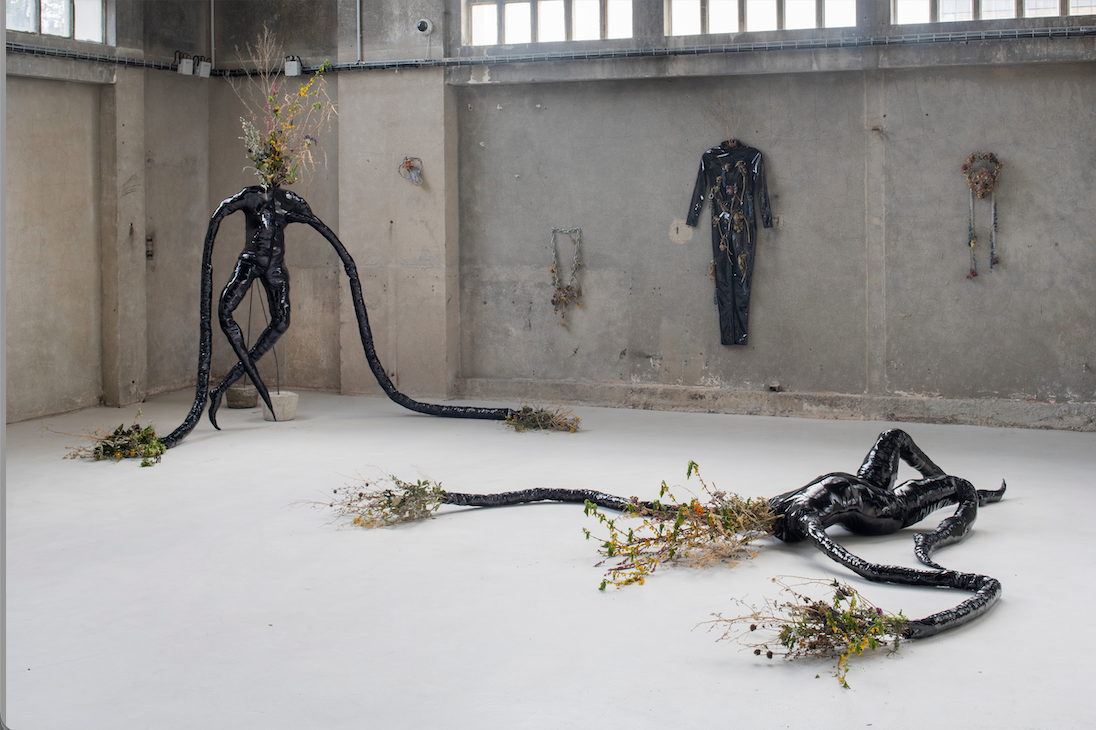
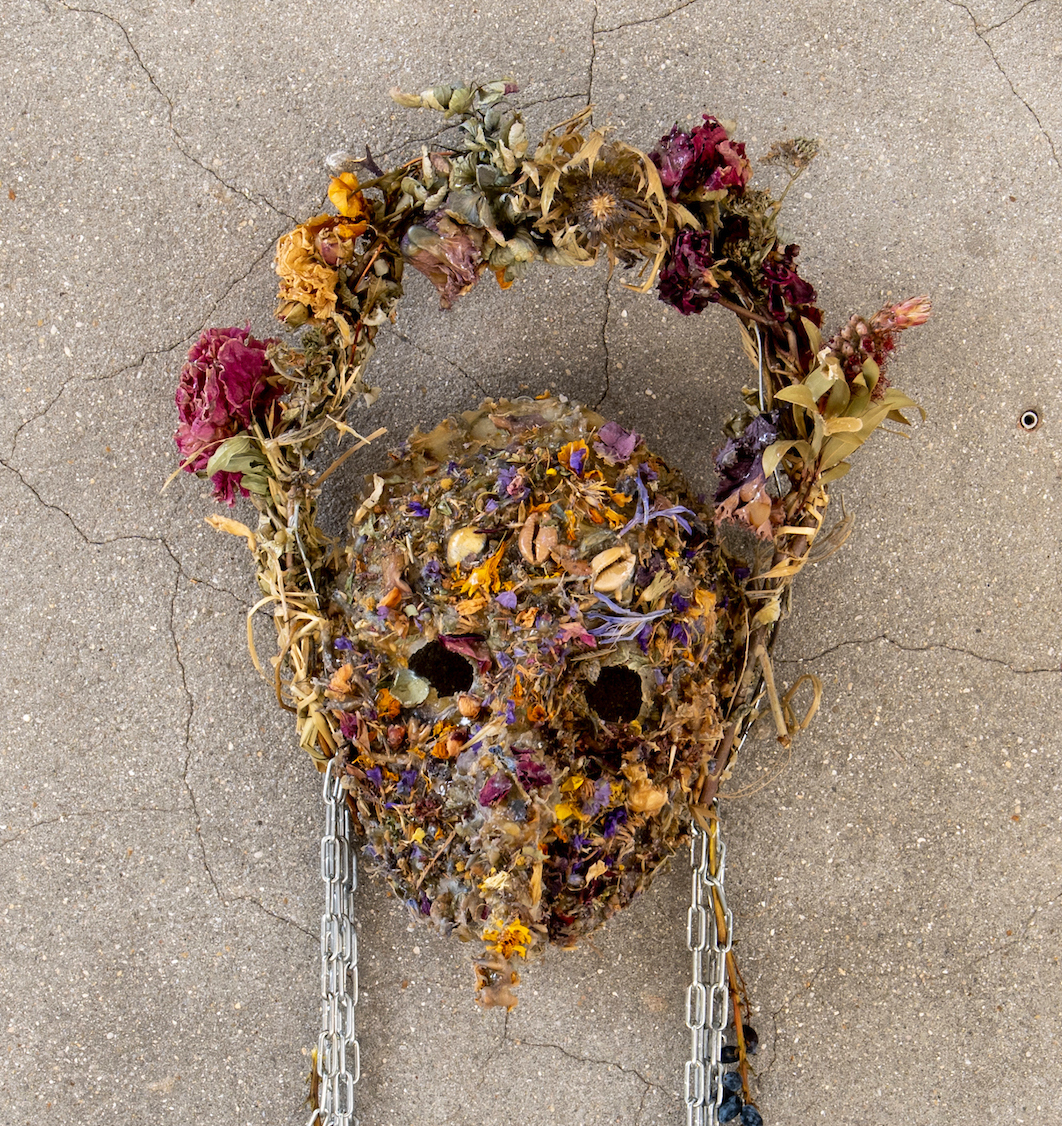
Johanna Rocard, Batailles Nocturnes, 2021, installation, vinyl jumpsuit, second hand clothing, beeswax, metal, dried flowers, latex, concrete.

Johanna Rocard, Batailles Nocturnes, 2021, installation, vinyl jumpsuit, second hand clothing, beeswax, metal, dried flowers, latex, concrete.
Performance in collaboration with Mahé Cabel, writings, second hand clothing, latex, sounds.
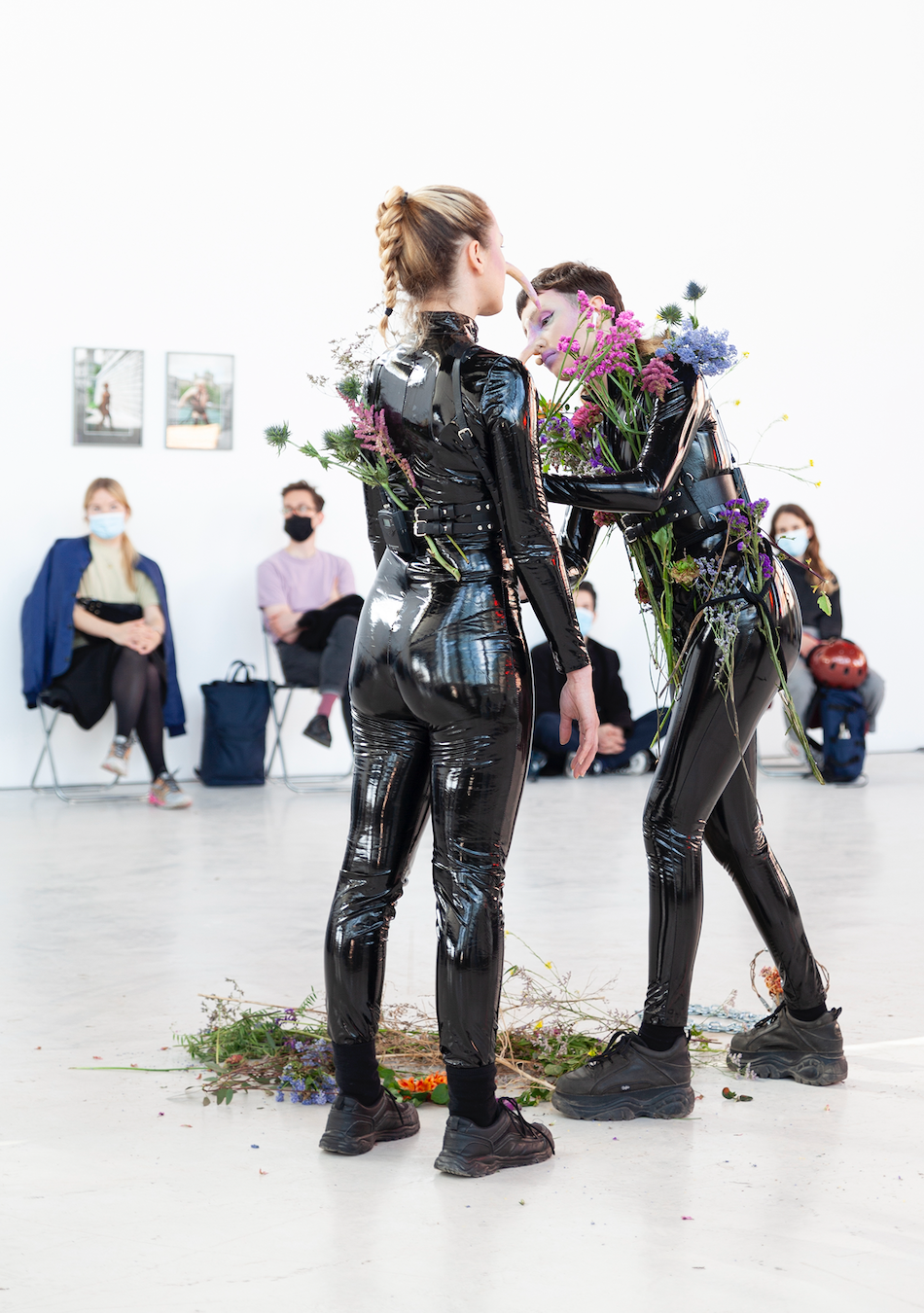

Félicia Atkinson, A Forest Petrifies, 2021, sculpture with fabric, vase and black ink, apples, ten prints mounted on brushed aluminium Dibond panels 10 x 15 cm, sound installation for the listening space, variables dimensions.
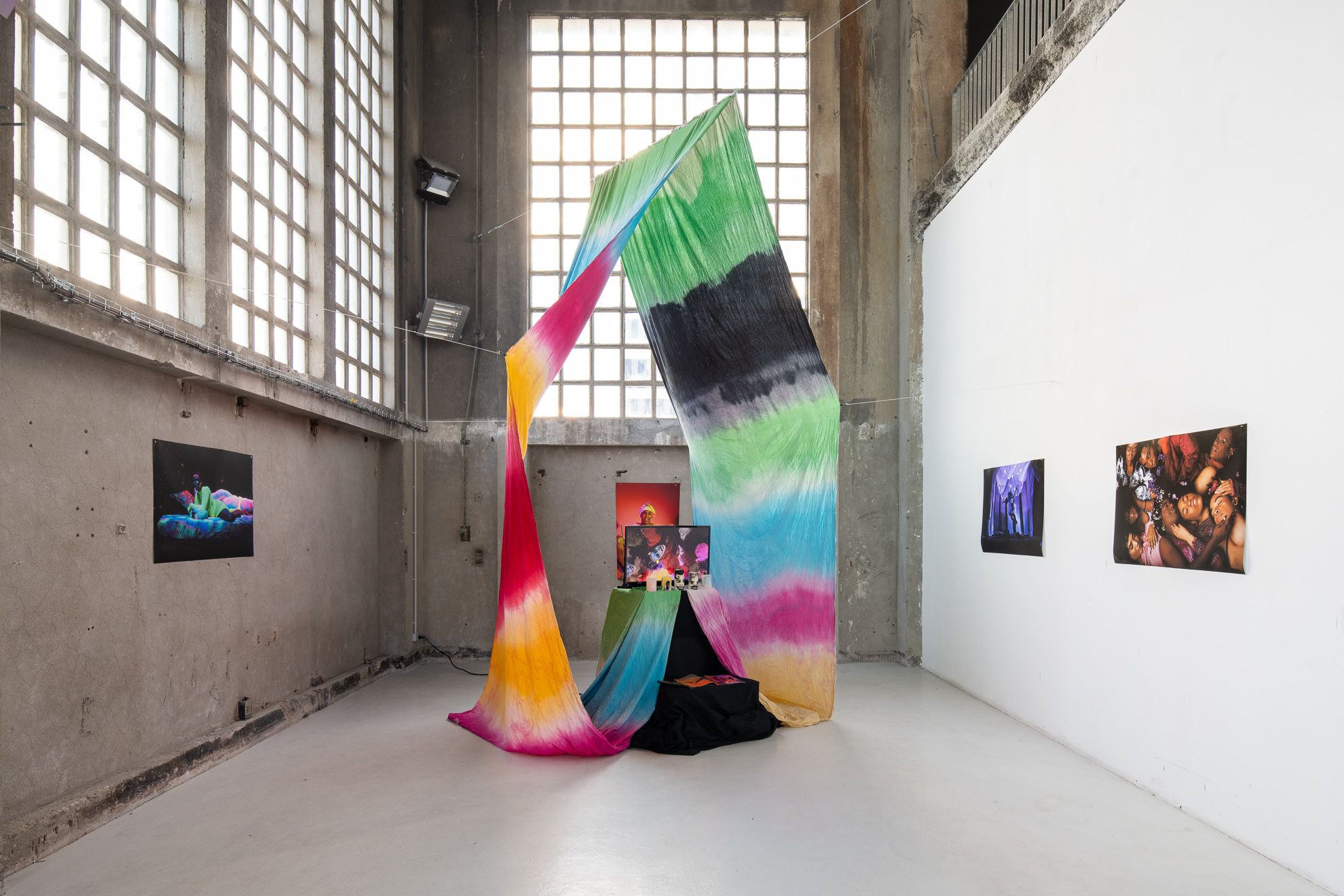
Black Power Naps, Black Power Naps Maquette, 2021, installation with fabric, candles, Black Power Naps Magazines and videos, photographs on matte paper, variable dimensions.
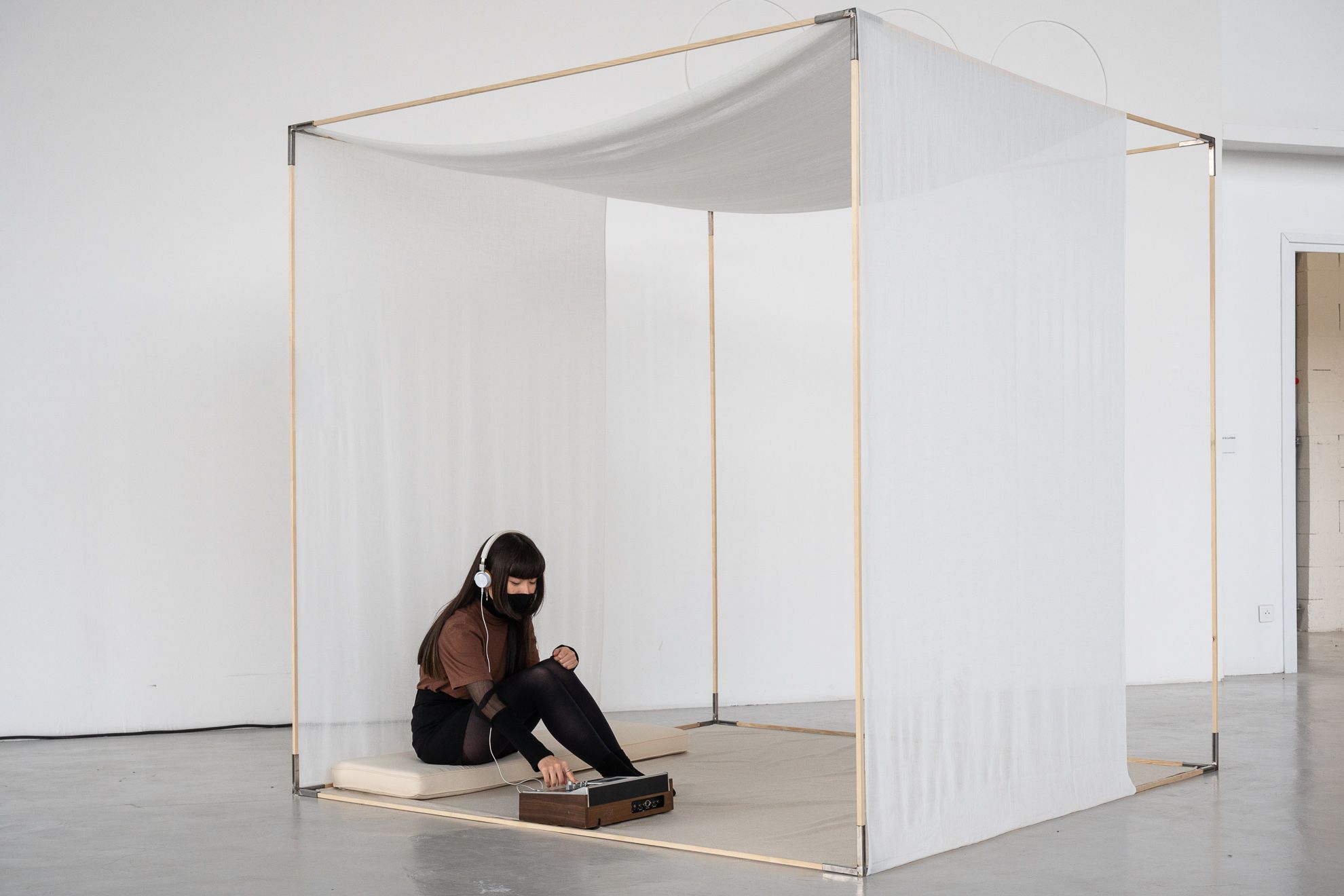
Amosphère, Gathering the Light, 2021, metal structure, headphones and mixed materials, variable dimensions.
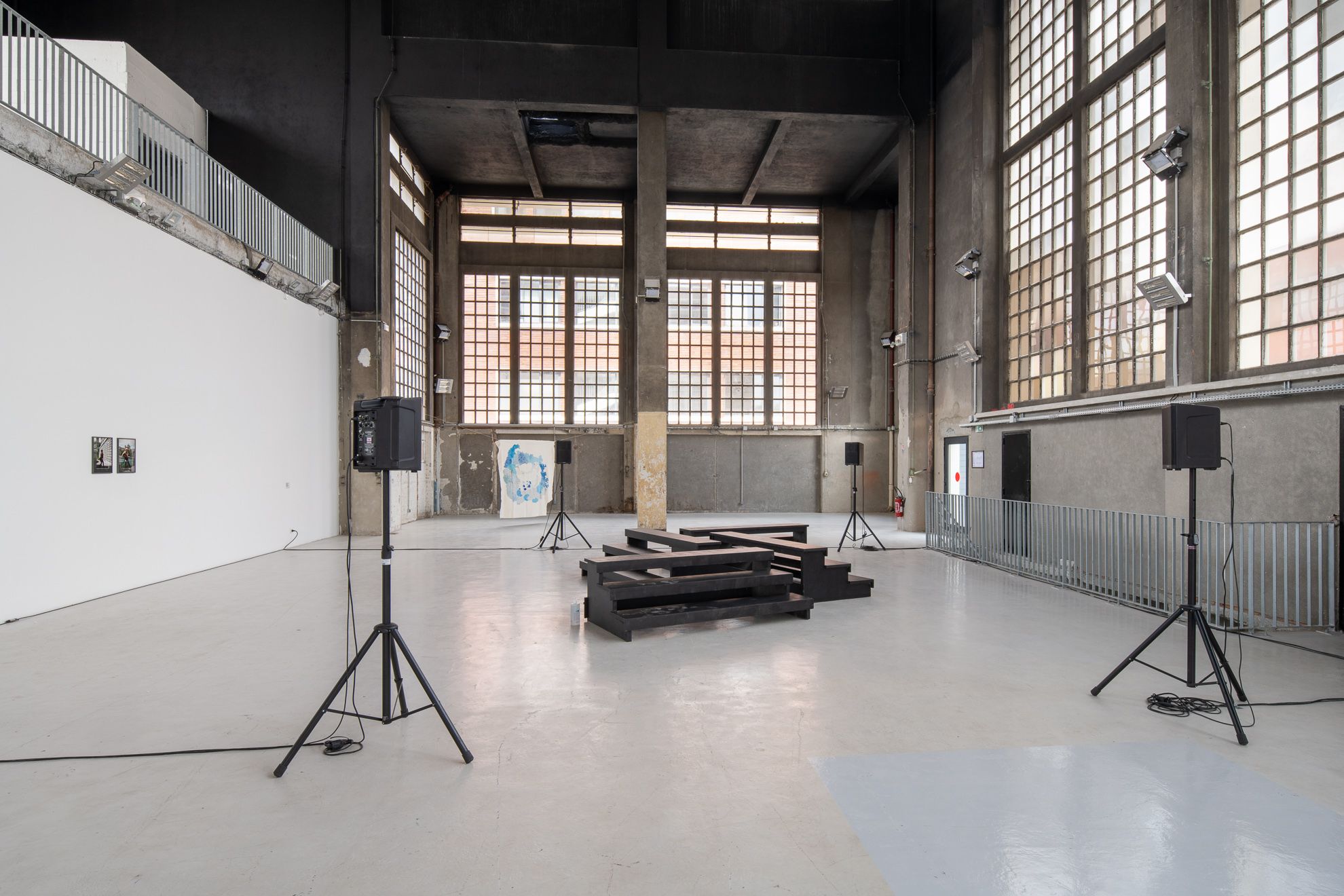
Espace d'écoute avec les pièces sonores:
Geoff Robinson, I am asleep in your night yet to come, 2020, 17'02 min.
Antoine Bertin, Méditations sur le SARS-CoV-2, 2021, 4 channels, 40 min.
Clare Milledge & Tom Smith, Strigiformes: Binocular, Binaural, 2017, 10'50 min.
Félicia Atkinson, If There Is No Where, 2020, 10’32 min.
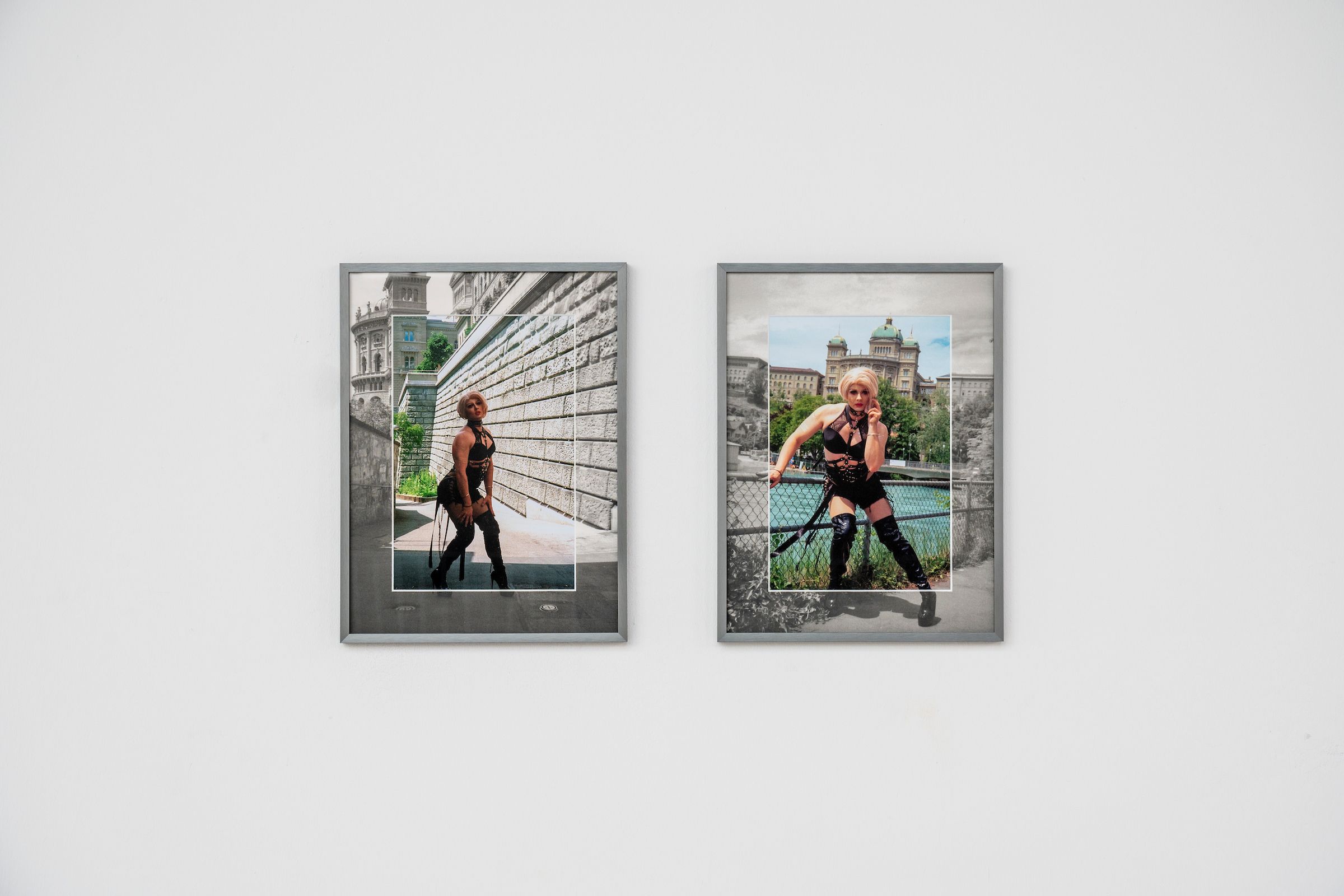
Philipp Timischl, Downtown Bern (Münzrain Bundeshaus), Downtown Bern (Scenic View) 2019, C-Print framed with passe-partout, 40x30cm.
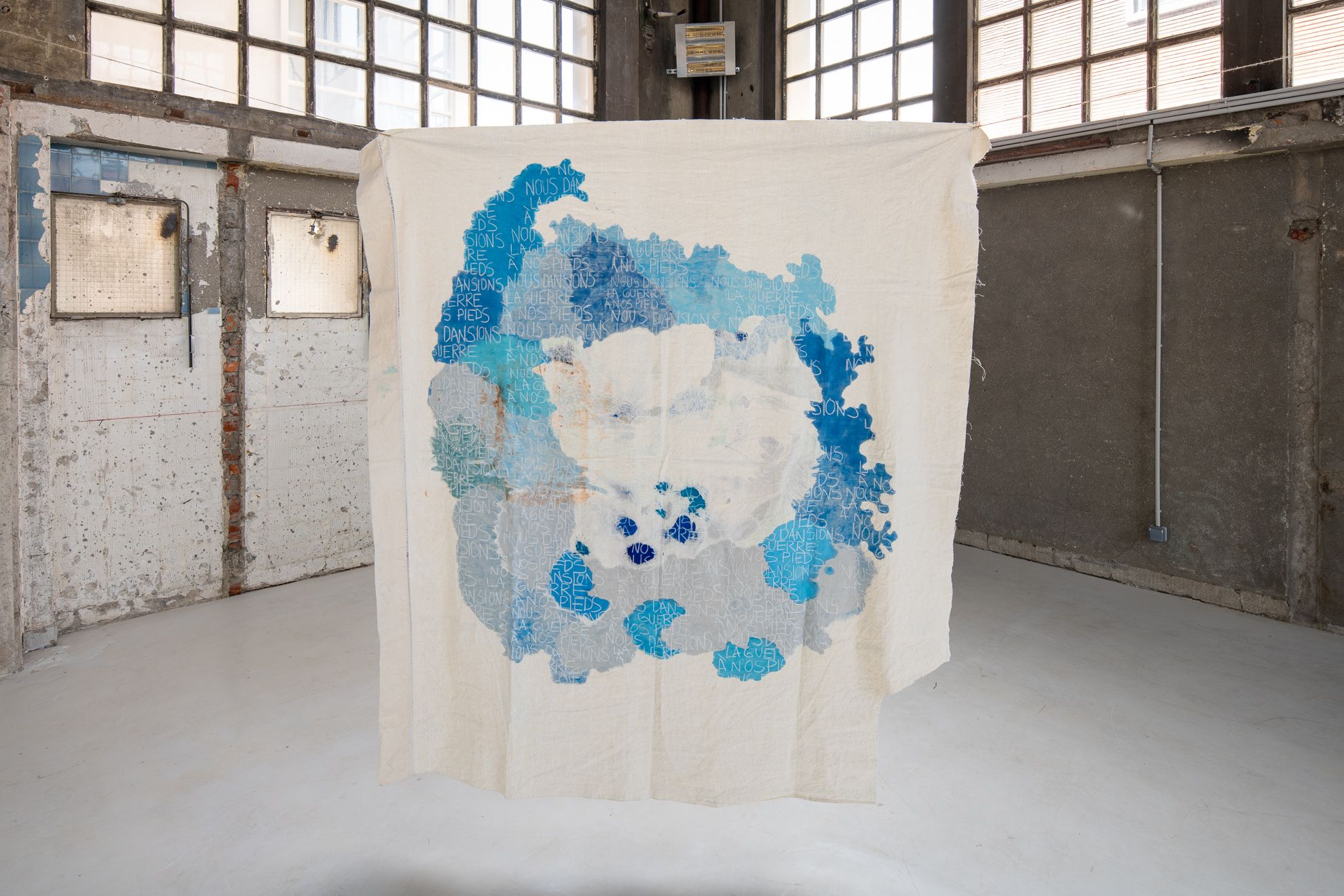
Andrés Avila Reyes, Nous dansions la guerre à nos pieds, 2020, Antique sheet, gouache, oil pastels, clay, nails, 185 x 168 cm.
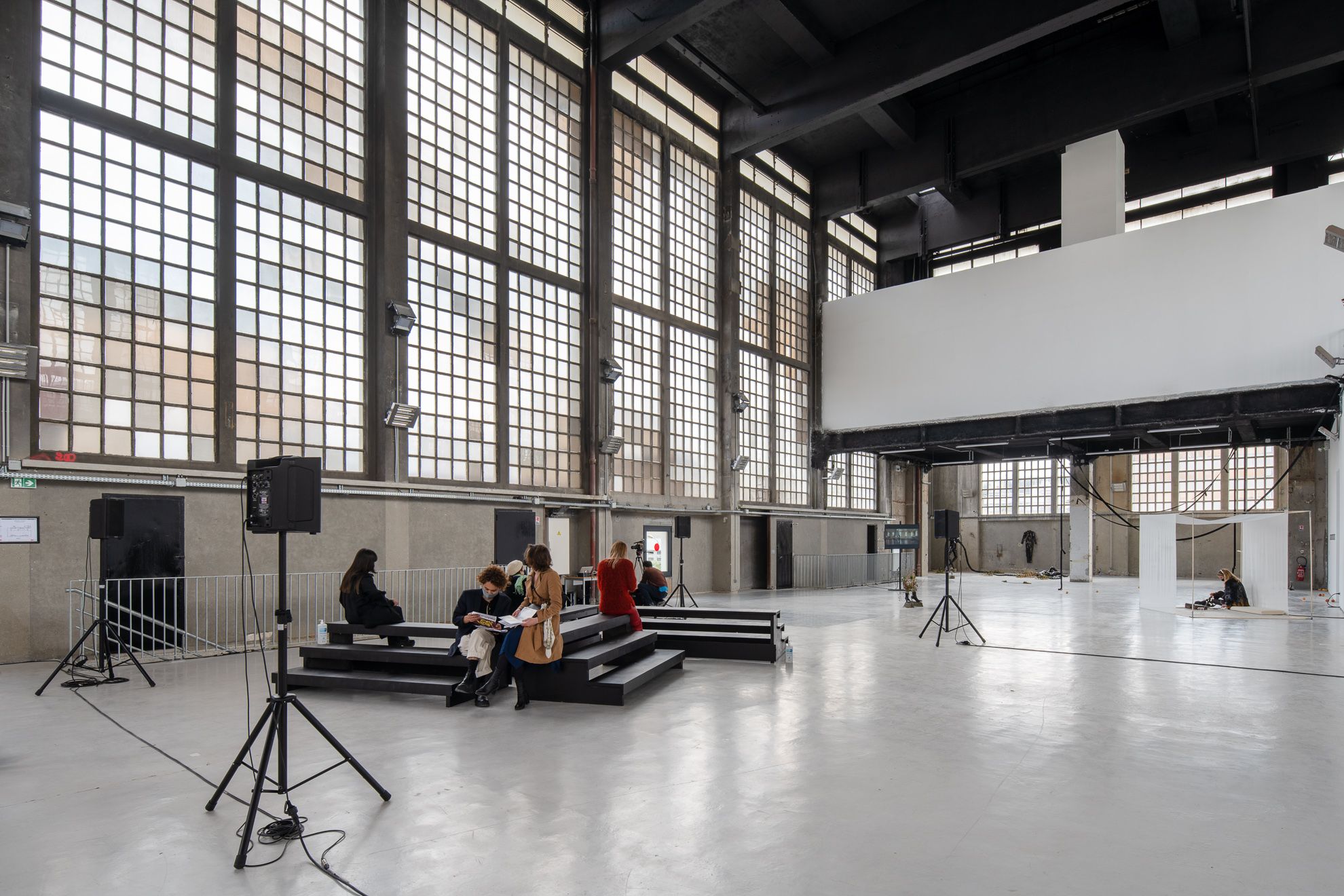
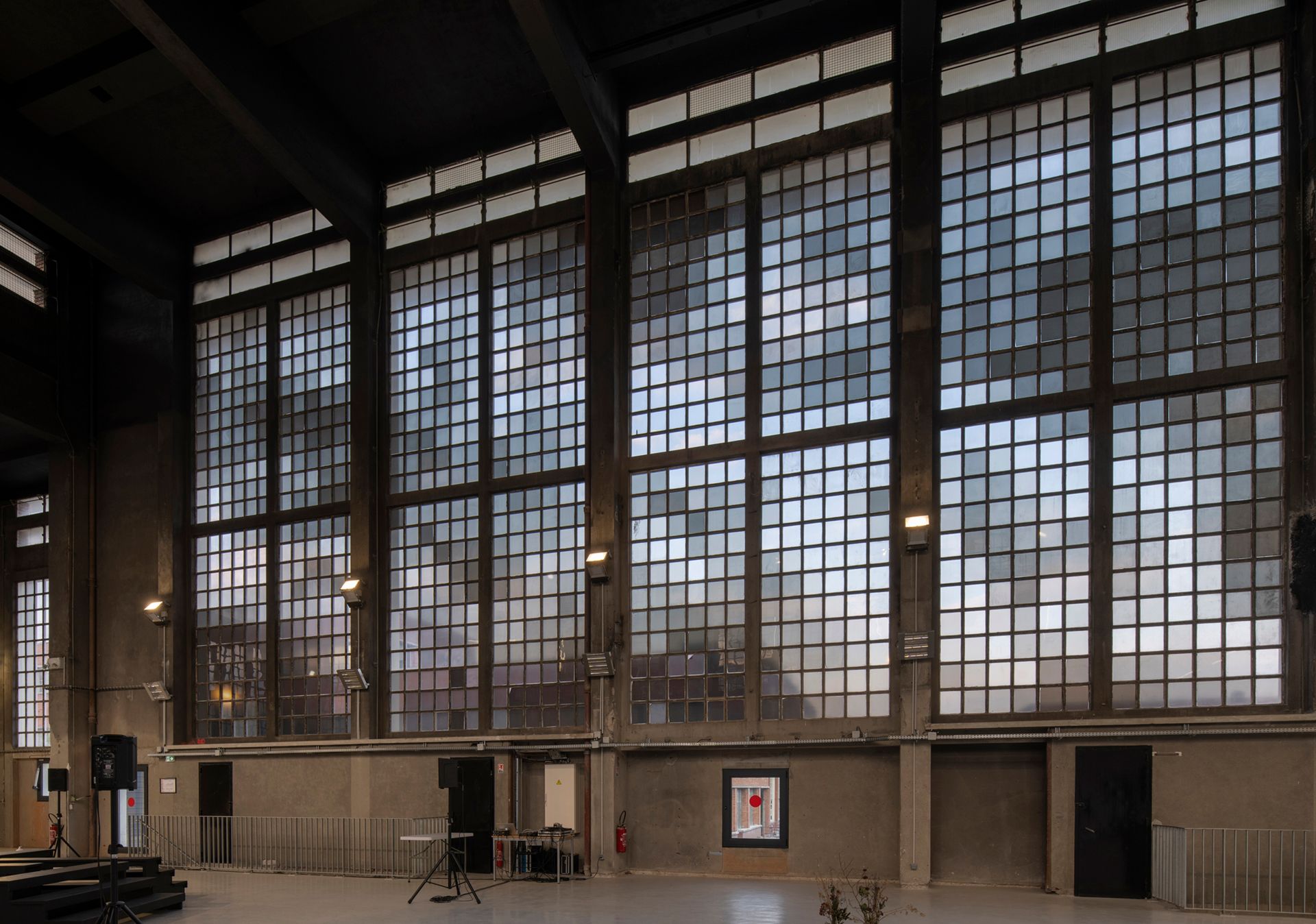
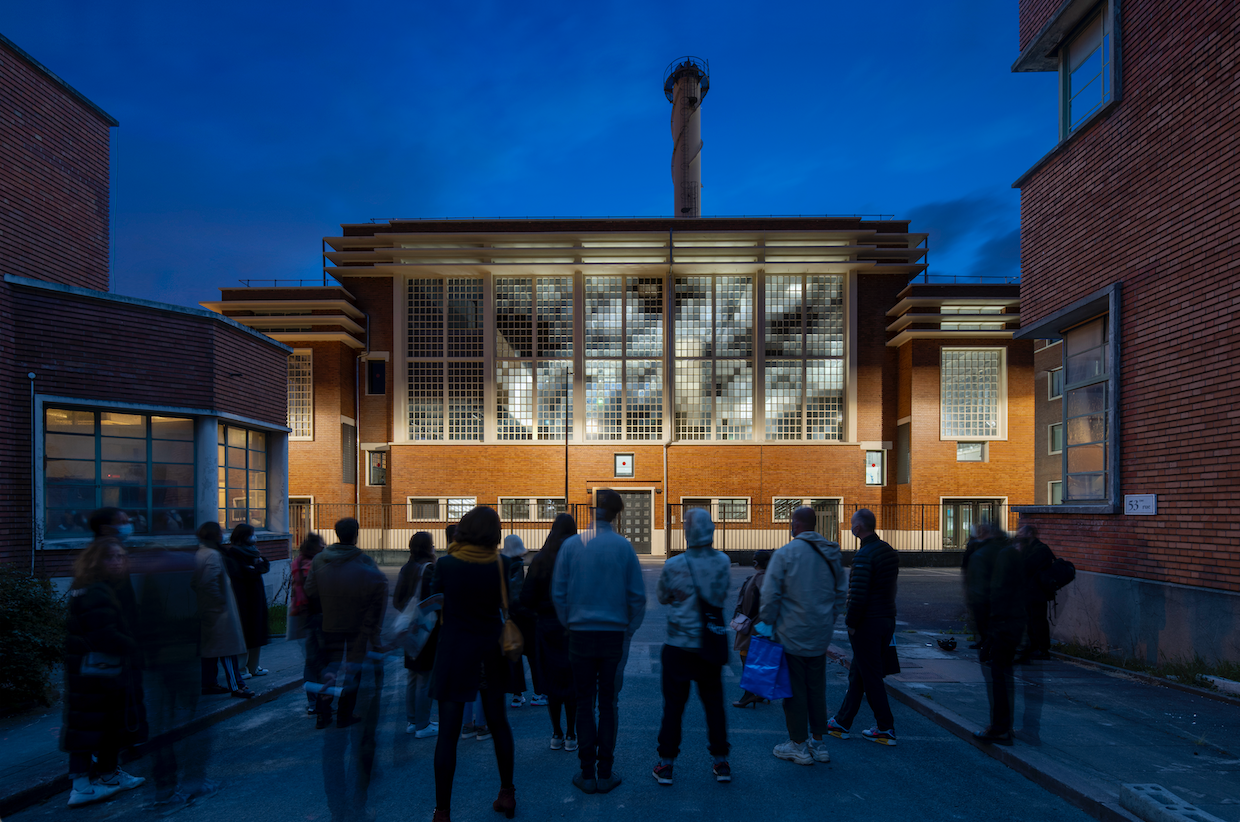
Alona Rodeh, The New Moon in the Old Moon's Arms, 2021, on-site installation with latex print and a performed tour.

Alexander Powers, inputs outputs, 2020, HD Video, 17’23 min.
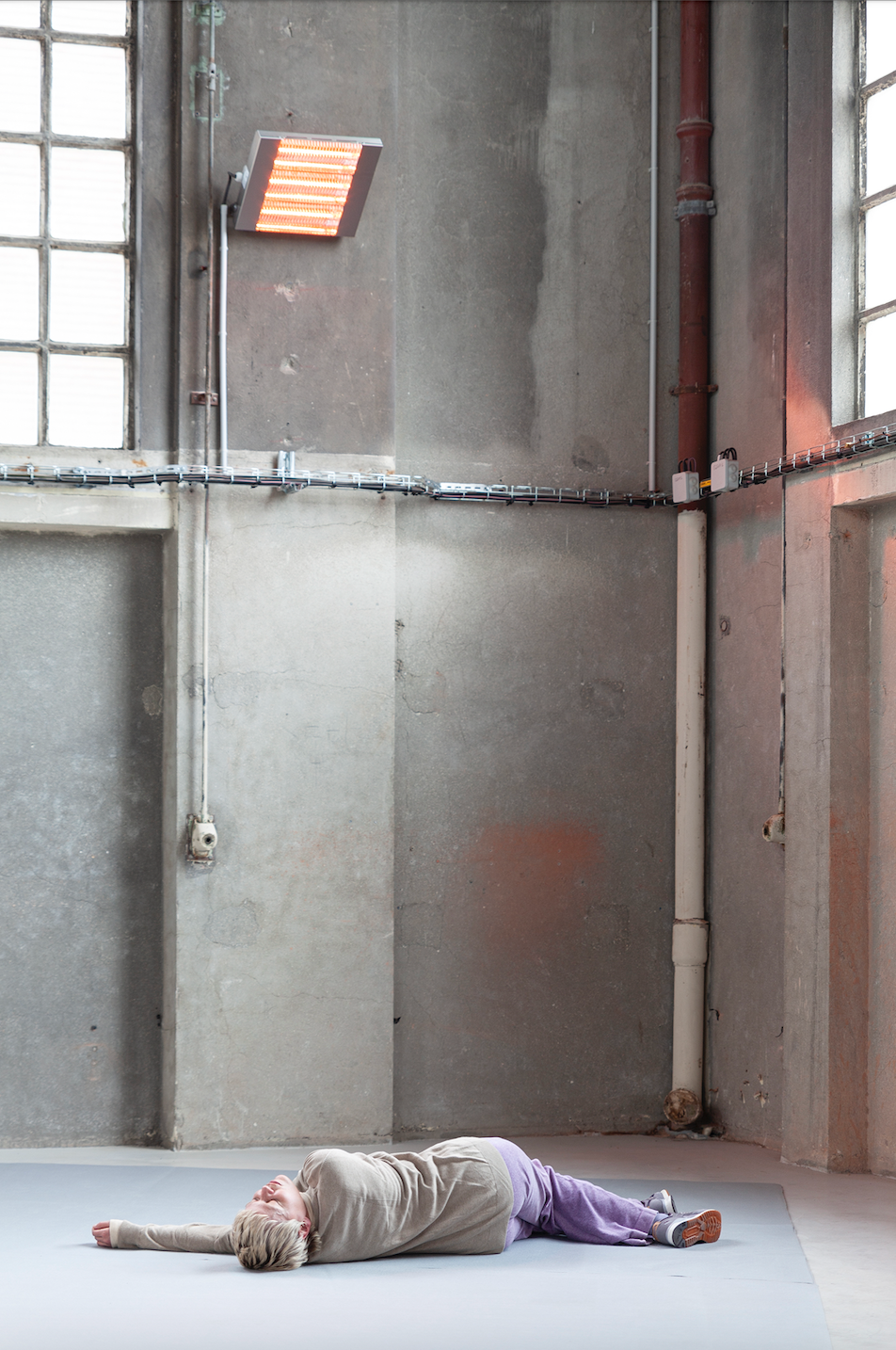
Masi Tiitta and Anna Torkkel, unnamed piece, 2016, 120 min
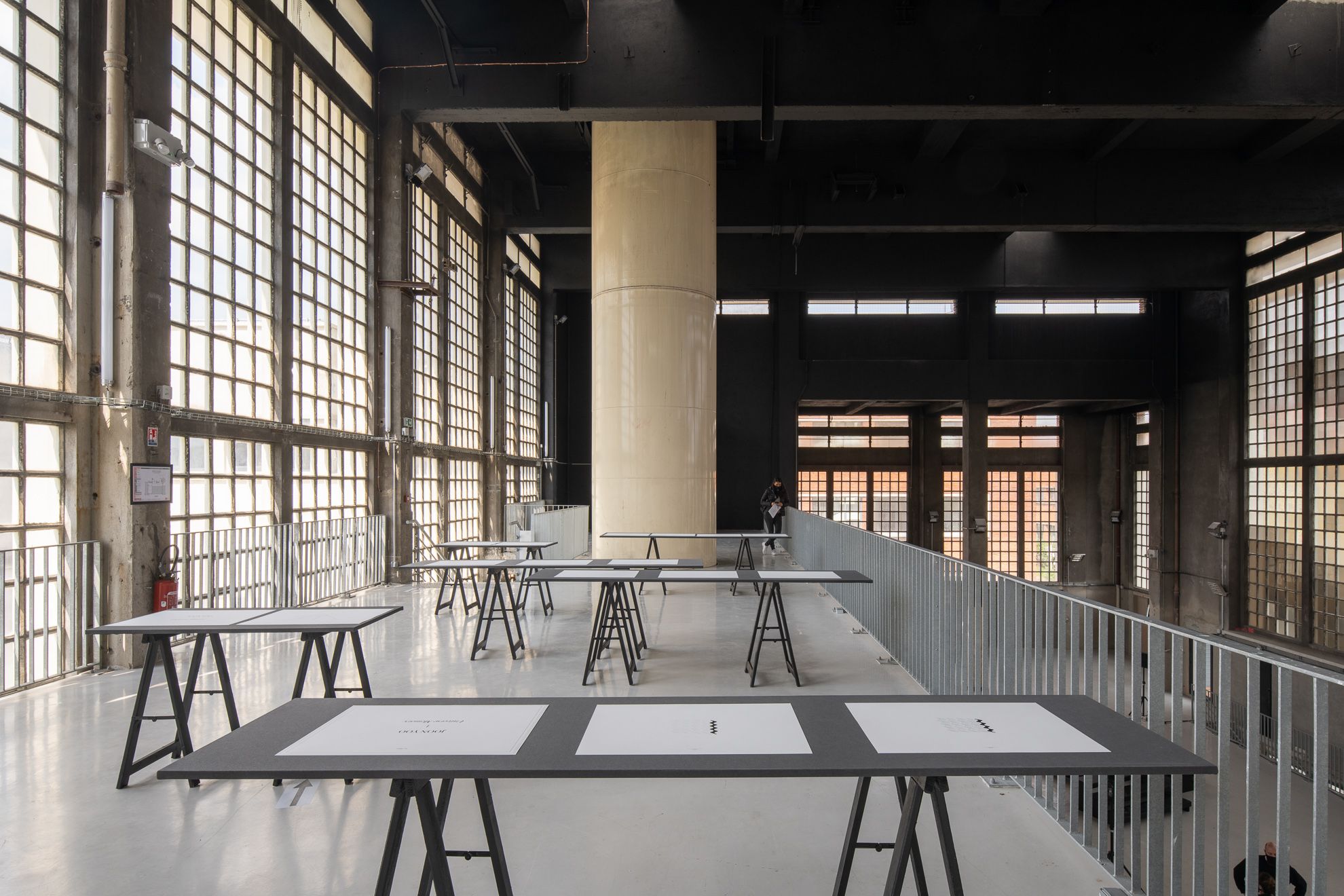
Joon Yoo, Universe Memory, photogravure de 21 pages sur papier Opal, 59x42, (boîte sérigraphiée, 42x60x2cm), 2021.
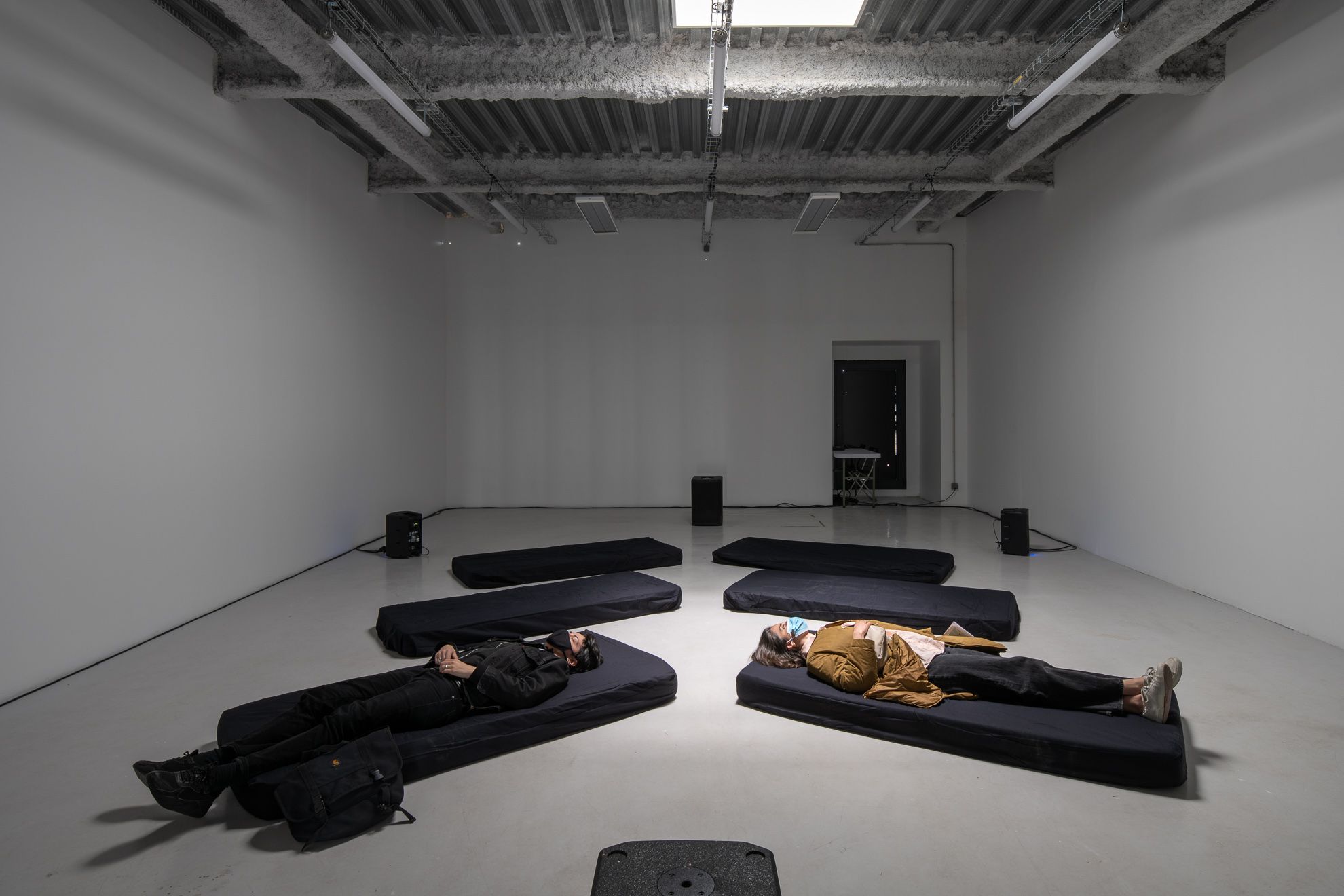
Méryll Ampe, One Night, 2021, sound installation with two speakers, two subwoofers, mattresses.
Ielles Veillent
Those who wake
Une création sonore et une nouvelle variation du poème d'Olivier Marboeuf "Ceux qui veillent les images nègres" réalisée par Maïté Chénière (aka Mighty). Nouveau rythme et battement du texte et de la voix sur un dance floor imaginaire. Nouveau lieu possible pour faire apparaître des images qui luttent. Nouvel hymne à la nuit.
« Ceux qui veillent les images nègres », poème de et lu par Olivier Marboeuf
Texte à lire ici en français et anglais ici.
A sound mix and a new variation of Olivier Marboeuf's poem "Those who hold a wake for negro images" produced by Maïté Chénière (aka Mighty). New rhythm and beat of text and voice on an imaginary dance floor. A new space for revealing images in fighting . A new hymn to the night.
"Those who watch the negro images", poem by and read by Olivier Marboeuf
Read the text in English here.
Nuit Blanche - Jeunes Critiques d'Art
Publication
Dans la nuit du 30 avril 2021, six critiques d'art, du collectif Jeunes Critiques d'Art, ont passé une nuit blanche dans l'exposition Freedom of Sleep et chacun on produit un texte qui sont réunis dans cette publication (PDF ci-dessous):
On the night of April 30 2021, six art critics, from the Young Art Critics collective, spent a sleepless night in the Freedom of Sleep exhibition. Each of them produced a text which are brought together in this publication ( PDF below):
Au commencement était un son : Joon Yoo
Text
Au commencement était un son.
Un son électronique dans un désert, qui emplit l’espace. Il n’y a aucun mur, aucun relief pour lui faire obstacle. Il est le maître des lieux, et se diffuse partout. S’insinue partout.
Nul besoin de s’évertuer à en chercher l’origine. Il se forme à des kilomètres d’ici. Il émet aussi en nous. Nous sommes chargés d’électricité. Ce son nous transforme en émetteur-récepteur.
Omniprésent et omnipotent, il a tué le silence. L’oreille humaine ne peut plus écouter le silence, ni l’accepter. Le silence défie même les funambules, et gagne toujours. Sans bruit, plus d’équilibre. Ce son est, peut-être, notre perche qui oscille entre droite et gauche, et nous empêche de tomber. Il est aussi, sans doute, un fil suspendu dans le temps et l’espace. Le son est à l’origine d’une série de dessins de Joon Yoo. D’abord de simples dessins à main levée, sur des feuilles volantes. Puis des dessins travaillés à l’ordinateur. Ils composent un opéra visuel.
Il y a des actes, et à l’intérieur de chaque acte, six scènes. L’infini de l’univers, la trajectoire orbitale des planètes d’un côté, l’élan de la marche humaine de l’autre. Le très grand et le très petit sont co-présents dans ces dessins. Joon Yoo trace en 2D les contours de l’espace 3D. Partitions expérimentales, elles ont une double finalité. Dans un premier temps, elles sont destinées à être jouées par un instrument musical pour produire un son expérimental et nouveau. Elles ont également vocation à être lues visuellement La portée, les cinq lignes classiques d’une partition, n’est plus horizontale comme il est d’usage. Elle devient courbe, boucle, s’éclate en lignes fines et imprévisibles sur l’espace papier. C’est ici, précisément ici, que le jeu entre les différents espaces et dimensions prend tout son sens. Sur l’espace plan du papier, les lignes s’envolent, se fragmentent, avec pour objectif et conséquence une résonance dans l’espace tridimensionnel, celui de la vie, qui soit innovante et radicale. La liberté créatrice du dessin s’accompagne d’une sonorité encore inconnue diffusée dans l’espace physique.
Musique optique ou bien poésie visuelle, ces partitions traduisent une langue universelle, qui n’a pas besoin d’alphabet. Pas de a, ni b, ni c, mais des traits. Elles parlent le langage de nos émotions et de leur ondes, des vibrations de notre corps dans l’espace, du passage du temps. Avec des règles, et des infinies variations, du pianissimo à l'arpeggio, Joon Yoo crée un ouvroir de poésie potentielle.
L’acte Gradiva, inspiré du bas-relief éponyme de Pompéi, sera le point de départ de la performance de Joon Yoo pour l’exposition Freedom of Sleep. À partir des dessins d’un mouvement permanent, de la mise en action inévitable de nos corps, Joon Yoo souhaite créer une performance marchée. Elle offrira une interprétation physique du rythme sociétal qui s’impose à nos consciences et à nos corps, une incarnation de l’accélération forcée de nos modes de vie. Le travail de Joon Yoo est imprégné de cette domination temporelle de la société sur les individus. Son dessin, ses vidéos et performances cherchent à trouver une parade à notre impuissance. Notre impuissance à composer le temps, à le décider, à s’affranchir de ses obligations. Le travail de Joon Yoo offre un répit. C’est fuite en avant vers la liberté et une manière d'échapper à cette “Time MachineInfernale” qui nous broie. La performance réalisée pour Freedom of Sleep permet à l’artiste d'extérioriser, d’expulser par le corps ce que la société lui dicte. L’expérience du temps, des rythmes temporels trouvera une personnification dans l’espace d’exposition, et ainsi la boucle de Joon Yoo est bouclée : de l’invisible au visible, du mental au corporel, du lisse au relief, du dessin à la sonorité, du temps à l’espace.
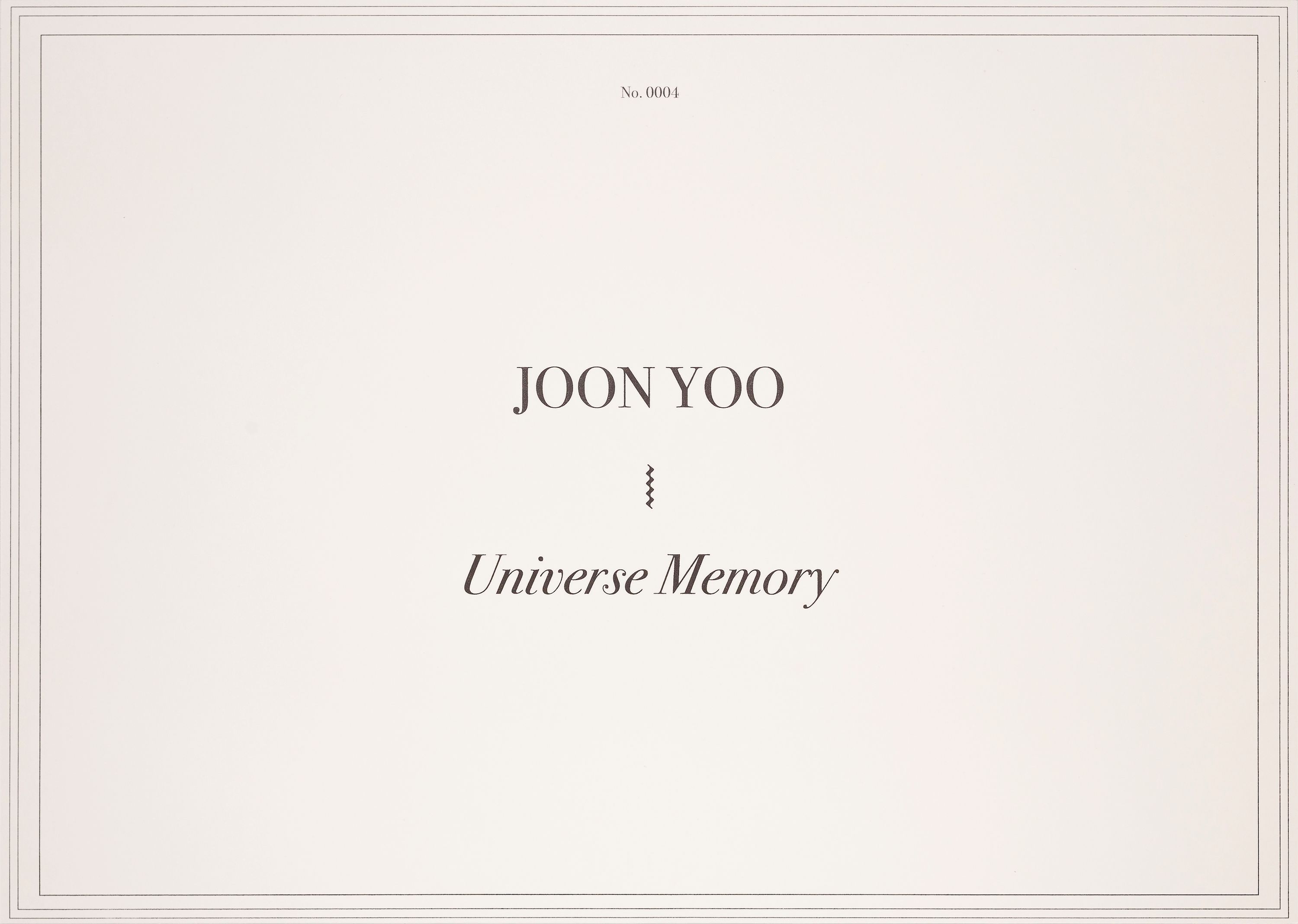
Gradiva, troisième chapitre de la série de Universe Memory,
3 pages de gravure parmis 21 pages, photo gravure sur papier Opal, 5 exemplaires dont 2 Artiste Prouve, 59x42, 2021
L’impossible syndrome de Stendhal : Portrait de Farah Khelil
Text
Farah Khelil est une artiste. Farah Khelil est une chercheuse. Farah Khelil n’est pas une archiviste. Farah Khelil est une femme. Farah Khelil a été peintre, mais s’est émancipée de la peinture. Farah Khelil est une traductrice de l’émotion. Farah Khelil est tunisienne. Farah Khelil n’est pas une historienne. Farah Khelil est un peu punk. Farah Khelil n’est pas au service de la mémoire. Farah Khelil est une philosophe qui formule des idées et les exprime avec des formes artistiques plutôt qu’avec des mots. Farah Khelil est ontologue, et les choses sont des choses pour elles-mêmes.
L’oeuvre de Farah Khelil est une matérialisation protéiforme des intuitions de l’artiste. Les médiums utilisés, photographie, installation, dessin, composition sonore, écriture, sont aussi variés que les sources dont l’artiste se sert : archives historiques ou personnelles, objets chinés, objets trouvés, photographies documentaires. Cette grande diversité qui fusionne sous ses mains lui permet de jouer avec plusieurs niveaux de lecture et de perception. Chaque oeuvre est un univers en soi, où par le truchement du geste artistique se rencontrent micro et macro histoires.
Dans l’histoire personnelle de Farah Khelil, tout commence à son arrivée à Paris. Auparavant, elle a étudié les Beaux-Arts à Tunis, elle y a appris à maîtriser les techniques artistiques traditionnelles qui à l’époque étaient la norme en Tunisie. Sa pratique artistique est alors centrée autour de la peinture, une peinture hyperréaliste. Sa connaissance artistique est imprégnée de l’étude de l’Histoire de l’Art occidental.
À Paris, elle arrive dans les musées, et face aux œuvres elle se rend compte qu’elle les connaît déjà, qu’elle s’est déjà émue, qu’elle a déjà vibré à la lecture des explications de ces œuvres. Certains visiteurs peuvent subir des décompensations psychologiques face à des chefs-d’oeuvres, c’est le syndrome de Stendhal, mais Farah Khelil est immunisée. Elle a beau regarder, elle est physiquement présente mais émotionnellement ailleurs. Elle est dans les livres d’Histoire de l’Art qu’elle a longuement étudiés, elle voyage de reproductions en reproductions de ces chefs d’œuvre. Ce silence laisse se dessiner en creux la question de la rencontre avec l’œuvre. À quel moment rencontre-t-on une œuvre ? Quand la voit-on pour la première fois ? La voit-on vraiment et uniquement en lui faisant face ? Cette interrogation du regard et de la perception n’est pas sans rappeler La Lettre sur les aveugles à l’usage de ceux qui voient de Denis Diderot. Devant un tableau, on peut ne pas le comprendre, ne pas être touché par lui, quand bien même on l’a déjà étudié. Même un aveugle qui trouverait la vue aura besoin de temps pour faire la synthèse entre ce qu’il a pu vivre avant et ce que son œil découvre alors.
Mais revenons à Farah. Nous sommes en 2007 et cette année marque la mort de la peinture dans la pratique de Farah Khelil. Cette mort est féconde, puisque c’est en réalité une naissance, l’acte fondateur de tout ce qu’elle crée depuis, un éveil qui va lui permettre de définir sa posture intellectuelle et artistique. Farah Khelil prend conscience de la prégnance de la culture médiatique de l’art occidental en Tunisie. Médiatique dans le sens où l’art occidental est examiné sous toutes ses formes, et qu’elle y a accès par des analyses visuelles ou textuelles. Entre elle et les œuvres, il y a toujours un autre médium. Cette distance imposée amène Farah à réfléchir sur la notion d’effet, d’impact que les œuvres ont sur nous. L’œuvre de Farah est tout entière tournée vers la question de la réception, et des différentes postures qui la rendent possible : un point de vue ou encore un point d’écoute. Un peu à la manière de Joseph Kosuth qui rassemble la chaise, son image et sa définition, la pratique de Farah Khelil intègre dans l’œuvre ses propres médias. La teneur de l’œuvre de Farah Khelil est celle d’une exploration constante du dispositif d’exposition, de transmission et de traduction. Le contenu est au service du contenant, c’est un prétexte pour l’artiste, pour lui permettre de faire vivre dans ses œuvres son désir de partage, d’échange.
Ici intervient la question de l’identité tunisienne, et c’est dans une logique de décolonisation qu’elle interroge son héritage, notamment artistique et culturel très largement marqué par la domination occidentale. Cette dualité, Farah Khelil sait aussi la mettre au service de son propos créatif. C’est le cas, avec la série Point de vue, Point d’écoute (Clichés II), initiée en 2012, dans laquelle Farah Khelil utilise des souvenirs du tourisme en Tunisie. Chinées en France, elle utilise des cartes postales qui ne sont pas des archives, mais un matériau plastique pour l’artiste. Elle y découpe des formes qui figurent sur la face image de la carte postale. Toujours présentées côté texte, en jouant sur ce qui est visible et ce qui est lisible, les cartes postales donnent à voir des vides initialement figuratifs, mais qui deviennent abstraits une fois la carte retournée.
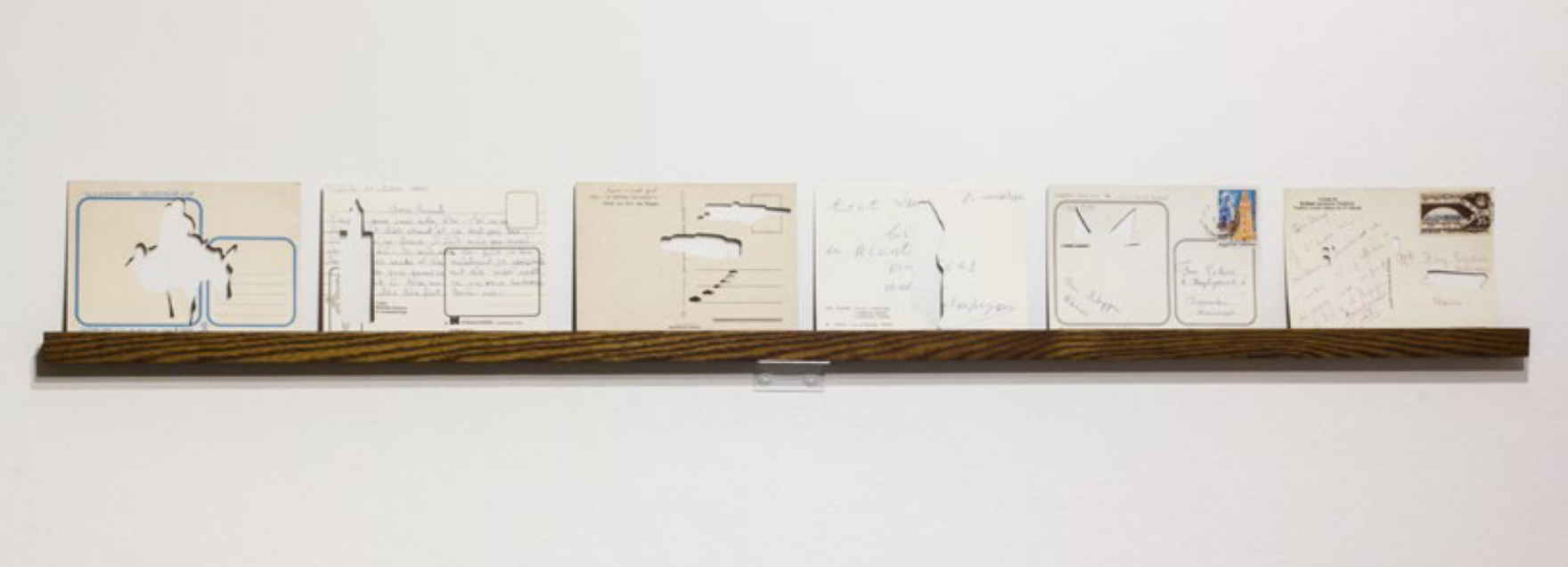
Point de vue, point d’écoute (Clichés II), 2013-2019
Cette technique du manque, du creux se retrouve dans d’autres pièces de Farah. Ainsi, la série Effet de surface, 2018, est un ensemble de diapositives pédagogiques d’Histoire de l’Art percées au laser. Les formes dessinées au laser sont des figures prises dans une encyclopédie. La série Fouilles, 2019, regroupe des diapositives des sites archéologiques de la Tunisie Romaine percées au laser, présentant des textes correspondances de visiteurs de la Tunisie prises dans les cartes postales. Ces séries font intervenir elles aussi le rapport entre culture occidentale et culture tunisienne.
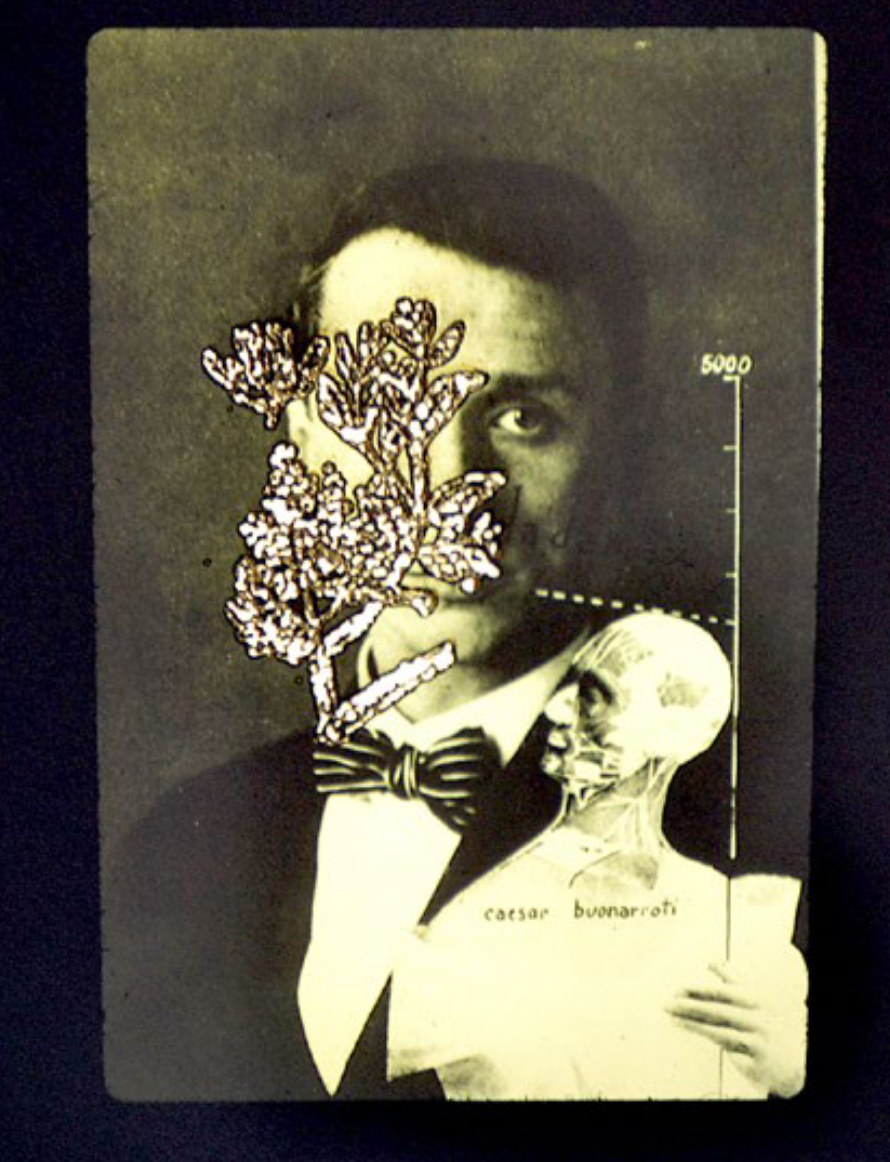
Effet de surface, 2018
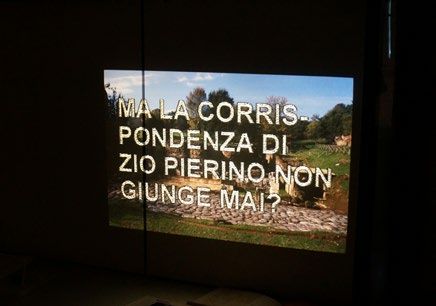
Fouilles, 2019
Dans la seule série de peinture de l’artiste, Point de vue, point d'écoute (clichés 1), 2012, des petites toiles de paysages tunisiens destinées à être vendues aux touristes sont recouvertes par l’artiste d’une peinture blanche. Elle laisse tout de même le paysage original poindre par endroit à travers des petites pastilles. On retrouve ici cette dimension de voir à travers, de trou qui ouvre notre champ de vision. Exposées toutes ensemble, elles forment une constellation du visible et de l’invisible.

Point de vue, point d’écoute (Clichés I), 2013
Pour l’exposition à la Fondation Fiminco, Farah Khelil a choisi de créer des nouvelles pièces des séries Notes de chevet et Point de vue, Point d’écoute (Nuit Blanche), dans une installation adaptée au propos de l’exposition, et qui poursuit la recherche artistique de l’artiste. La série Notes de chevet a commencé en 2017, à l’occasion d’une résidence à Gafsa en Tunisie. Cette région du Sud de la Tunisie est une rencontre entre son histoire familiale personnelle et un paysage naturel atypique. D’un côté, elle parcourt la région avec un appareil photo pour immortaliser l’horizon et ses détails végétaux. De l’autre, elle rend visite à une tante de son père qui lui raconte l’histoire de sa famille, photographies à l’appui. Son œil est attiré par les petites tables de nuit, dont le plateau supérieur est vitré et fait office de cadre horizontal pour des photographies familiales. Farah Khelil décide de reprendre ce dispositif de monstration privé et domestique et d’en faire le support d’une hybridation photographique. En effet, Farah Khelil mêle archives et photographies personnelles, et surtout les aplanies. Elle brouille nos sens, celui de la profondeur et de la perspective, puisque des images différentes sont unifiées par un geste de composition. Cependant, elle traite ces archives non pas dans une optique de mémoire, mais plutôt comme une cartographie réflexive des expériences vécues. La table est un tout, aussi bien entre la pratique artistique dont il sert de support, que pour son histoire antérieure d’objet domestique. Dans cette dynamique, Farah abolit toute forme de hiérarchisation entre les sources, entre les médiums, entre l’image et le texte.
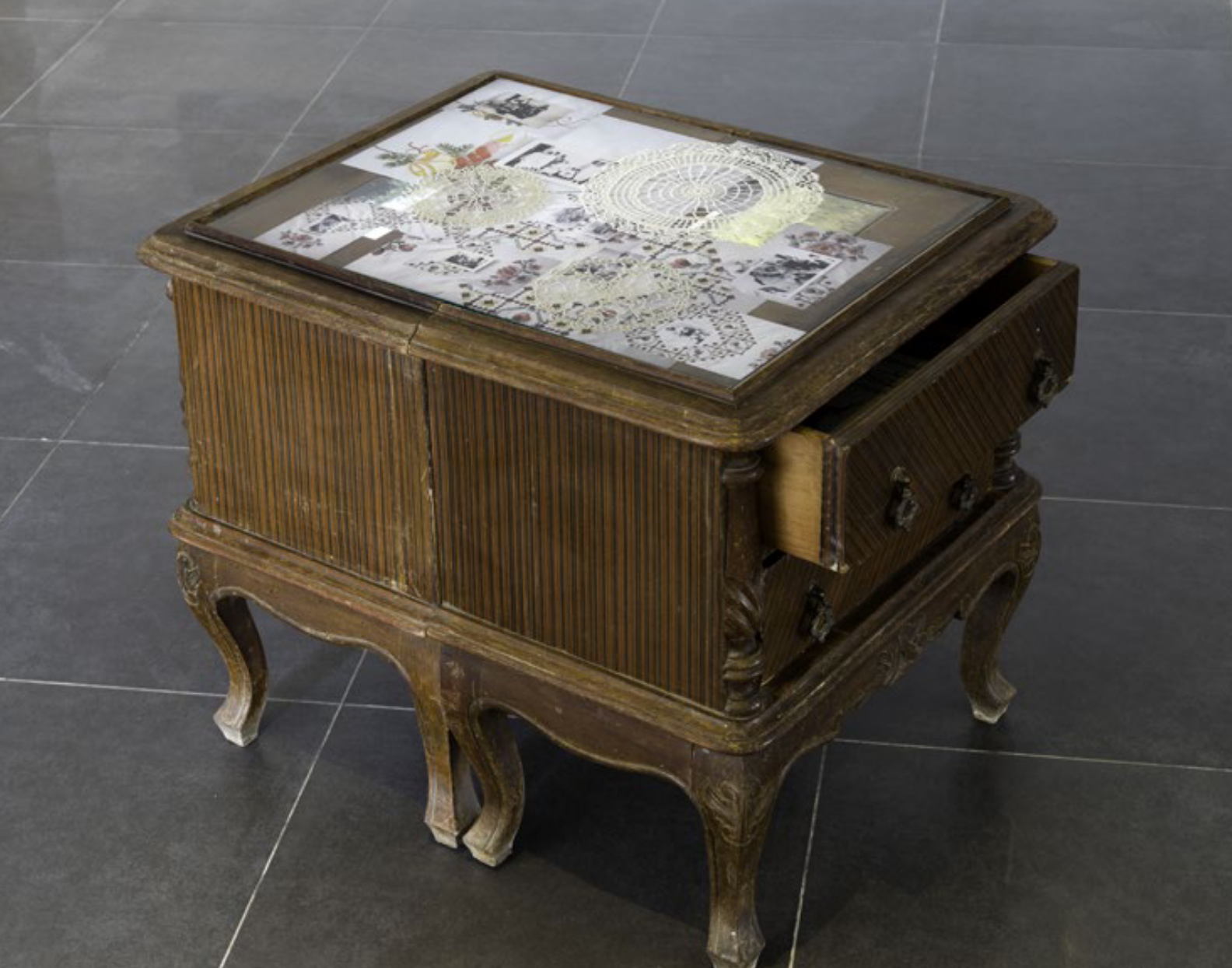
Notes de chevet #1, 2017
Pour l’exposition à la Fondation Fiminco, Farah Khelil va reprendre ce format des tables de chevet, en développant cette fois un travail de sérigraphie de textes sur des napperons. L’exposition Freedom of Sleep, pensée comme une exploration de l’insomnie, de la désynchronisation des corps et de la société, donne à Farah Khelil l’occasion d’explorer un nouveau sens de la série Notes de chevet. L’objet en lui-même, s’il sert de support pour une réalisation artistique, n’en reste pas moins un objet du quotidien, témoin de nos nuits et de nos insomnies. L’artiste utilise l’objet dans sa totalité, de sa condition matérielle à sa portée émotionnelle. Les textes sérigraphiés sont des extraits des forums internet où les gens partagent leur témoignage sur l’insomnie. Farah Khelil revisite le média texte, comme autant d’histoires personnelles pour en faire une œuvre avec une portée universelle, qui amusera, résonnera, interrogera les visiteurs.
En définitive l’œuvre de Farah Khelil est née d’une émancipation mentale, visuelle et artistique. Émancipation rime avec liberté, et c’est véritablement la liberté qui guide Farah à casser les codes, détourner les objets et les idées et s’affranchir des règles.
Dead Tired
Entretien avec Chelsea Hopper (EN)
Photo-interview
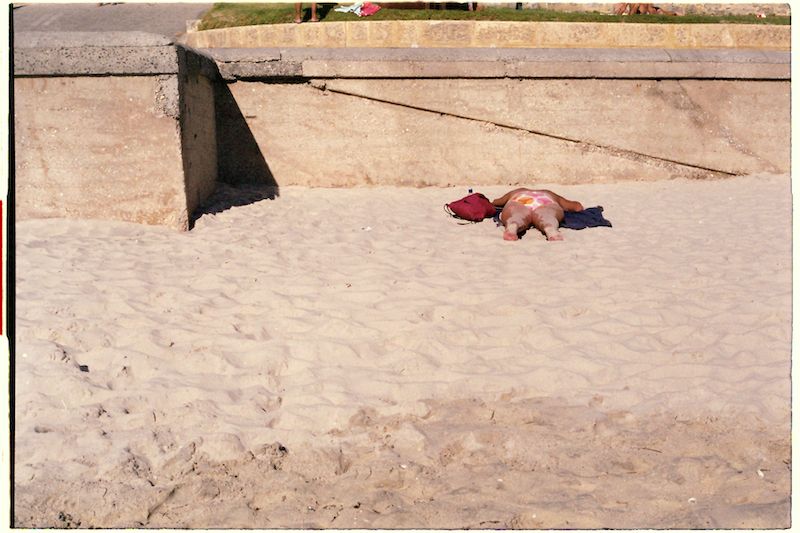
Chelsea Hopper, Cottesloe Beach, (Dead Tired series), 2011, inkjet print, 35.2 x 56.5cm
Anabelle Lacroix (AL): You made this series in 2011 when living in Perth in Australia where you grew up. Could you tell us about the context of this series at the time, and if you had a particular intention with this series in relation to your photographic work?
Chelsea Hopper (CH): At the end of 2010, when I just finished art school, I flew myself to New Zealand to visit a close friend. I took my camera with me. In part, it was to continue making pictures but also to document my time during that trip. There are actually two photographs in the Dead Tired series that were taken during this time, but looking back, I don’t think they were the catalyse for the project. I didn’t get the film developed until weeks later. They ended up wriggling their way into the series like a happy accident. As if I’d already started documenting these tired people before I really had to seek them out.
When I returned, I had a residency at Perth Institute of Contemporary Arts (PICA) in the clock tower over the summer. It was classic Perth weather (a dry heat) and on top of that, being situated in the tower with no air-con, sweating profusely, trying to be remotely productive was really challenging. I had to make something, and to manage my stress I ended up driving to the beach a lot. I took photographs, abandoned the studio I was given as the work I was doing ended up on the sand. I’d try to go to the beach at random times, often when there weren’t many people around. The only intention I gave myself at that point was to take photos of what was there and luckily it worked out. The series ended up being the main outcome of the residency. I remember when I gave an artist talk at the end of the residency, the prints started peeling off the walls; one by one. That’s how hot it was.
I was still trying to work out my own photographic language back then. In retrospect, I think I could’ve pushed myself a lot more. For me, there is a kind of hesitance, or resistance attached to this series, but maybe that doesn’t appear at all.

Chelsea Hopper, Unknown beach, (Dead Tired series), 2011, inkjet print, 35.2 x 56.5cm.
(AL): From watching sleepers on the beach, was there a particular trigger that prompted you to turn it into a photographic subject?
(CH): During the trip to New Zealand I was at a secluded beach somewhere near Tauranga, sitting near the shore after a swim in the ocean. I distinctly remember turning around and seeing an elderly man in shorts, white socks with shoes on, lying face down in the distance. His legs reminded me of my Dad’s. Tanned, skinny and weathered-looking. What struck me was that he didn’t appear to be sunbathing – there was no towel, he wasn’t “in” the sun nor was he wearing bathers. He sort of appeared out of nowhere. I think he was just sleeping but he also looked like he was dead. I walked up and took a photo. There is another photograph in the series I took back in Perth at City Beach that reminded me of this man with the exact same body type. Except he was sunbathing with little black togs on, lying on the hot sand, getting absolutely fried. I thought, what if this is the same guy? I wanted to keep recording these people, lying down, unidentifiable. I also latched onto the idea that these “sleepers” could be sunbathers, resters, relaxers and you never really knew exactly what they were doing. Perhaps they were tired or were they actually dead? Hence, the punny title of the series.
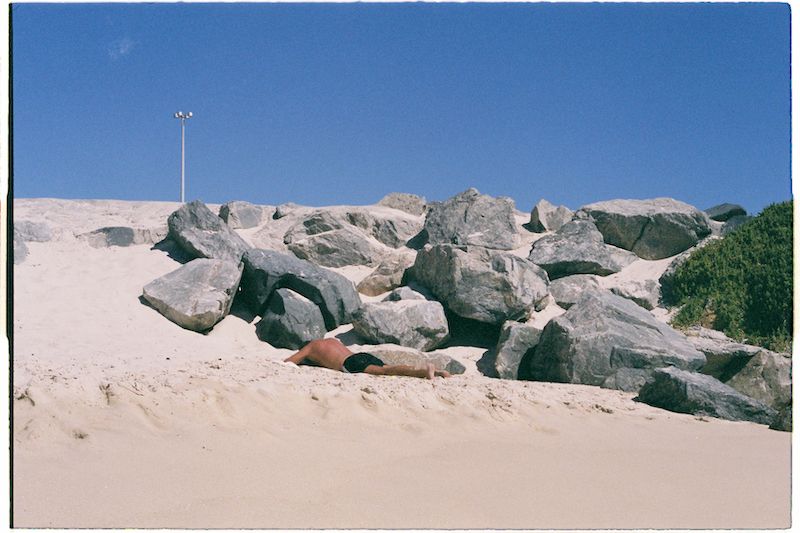
Chelsea Hopper, City Beach, (Dead Tired series), 2011, inkjet print, 35.2 x 56.5cm.
(AL): Did you have particular feelings behind the camera, did you feel a thrill being a voyeur when taking the photograph, stepping into the subject's intimacy, or on the contrary did you feel shy and discreet about it?
(CH): I was probably anxious, but I might be projecting that feeling retrospectively. I do remember there were times I found it a bit impossible to capture the subjects I wanted. At the beaches I went to, sometimes it was surprisingly busy and people got in the way of the camera frame. Beachgoers caught onto what I was doing pretty quickly (at least that’s what my paranoia was telling me). My camera also made a loud clicking noise whenever I closed the shutter so that didn’t help either. Having said that, I do think there was a thrill trying to find and capture the subjects. In almost all of the photographs in the series that made the cut, the subjects are alone, secluded. I’m not a confrontational person, nor did I seek to photograph anyone where they became identifiable—I wasn’t interested in that. None of the photographs are taken up close. I used a 50mm fixed lens, so I didn’t (and couldn’t) zoom in on anyone. By preferencing ambiguity, it ended up making it a little easier on myself to photograph them. It also gave me a certain agency to play around with how to frame each shot without feeling like someone was suddenly going to tap me on the shoulder.
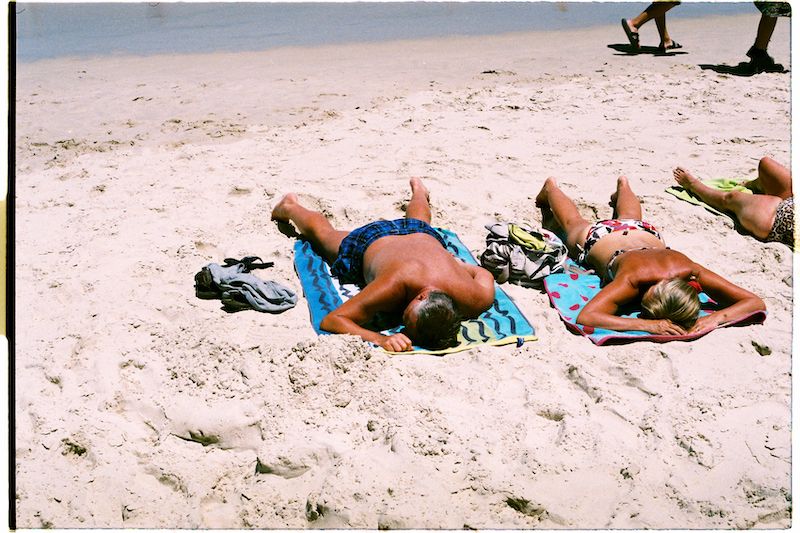
Chelsea Hopper, Cottesloe Beach 2, (Dead Tired series), 2011, inkjet print, 35.2 x 56.5cm.
(AL): Throughout the series it seems to me that you were interested in the formlessness of the body, is that something that you were attentive to? the flesh being completely relaxed, melting away…
(CH): I would say form rather than formlessness. Although there is one photograph that definitely speaks to the latter. She’s wearing a one-piece bathing suit, lying face down in front of a beach volleyball net. The harshness of the sunlight casts the same shadows onto her body as it does on the sand. Her skin is somewhat camouflaged in it, too. I was more interested in how these bodies formed the same positions/formations each time I encountered them. It was like playing visual bingo every time I stepped onto the sand. Heads down, arms splayed out. I think those ideas surrounding formlessness are there but came later on, after I got the rolls of camera film back. People looked a lot different once they were photographed. It might also be a result of the type of film I ended up using. The sunlight especially in Perth accentuates it, too. Perth is the brightest city in Australia, that’s why there are such harsh contrasts between the subjects and their surroundings.

Chelsea Hopper, Unknown beach, (Dead Tired series), 2011, inkjet print, 35.2 x 56.5cm.
(AL): Sometimes art has the capacity to “embody” something that is very present yet ungraspable, by making visible, by creating a displacement of sorts. For me, this is what is happening with this series, it holds the full ambivalence of sleep, rest and death in today's society, is that something that you could reflect upon?
(CH): Yes, absolutely. Since I’ve taken these photographs, I think that ambiguousness still holds weight. It crops up in all kinds of places. The other week I was watching Eric Rohmer’s 1981 film, The Aviator's Wife and Philippe Marlaud's character kept falling asleep in cafes. This is never explained in the film and it was so beautiful to watch. Was he just tired? Why do we get to watch him do this? The politics surrounding sleep and labour also speak to this, which I completely overlooked when I was taking those photographs nine years ago. Thinking back, I ask myself, why are these people sunbathing in the middle of a weekday, didn’t they have a job to go to?
I have a friend who just came back from teaching English in Japan who told me his students would often sleep in class. When he asked if it was even allowed, the response given was simply, “Oh it’s fine, they just need to rest”. Again, those lines are blurred. I mean, should we be allowed to embrace moments when we need to put our heads down? It also reminds me of the extreme opposite in Japanese culture, where they have some of the longest working hours in the world. There’s a great photographic series called High Fashion by a Polish photographer Paweł Jaszczuk depicting Japanese businessmen asleep in public. Here we have a similar situation where the viewer is unsure as to what is really happening in these images. Are they asleep from exhaustion or did they pass out from a night of drinking with their boss?
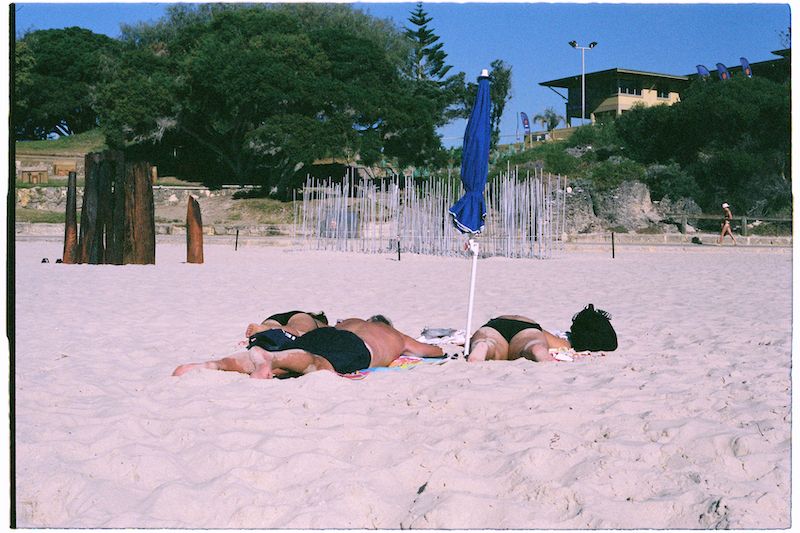
Chelsea Hopper, Cottesloe Beach 3, (Dead Tired series), 2011, inkjet print, 35.2 x 56.5cm.
(AL): Has your thoughts about this work changed since you realised it? through your work as a writer for example?
(CH): I still have most of the framed prints sitting under my bed, so every time I move house I get a quick glimpse of them. There is a certain fondness I have with the series and perhaps it speaks to why I’ve kept them all these years. I don’t think they have “aged” or gotten worse over time. What they represent, and how it's been represented photographically is still striking. So when you reached out about exhibiting them earlier this year, it kind of confirmed that feeling for me. They are bold and strange. Looking at them now, I think these images are also very awkward. I was hopeless with getting the aperture right, glare and reflections from the ocean also interfered with how they looked in the end. Using the wrong kind of film also complicated how they were printed. I don’t think any of that really matters to anyone except myself because I know where all the mistakes were made. I just wish I’d taken more photos.
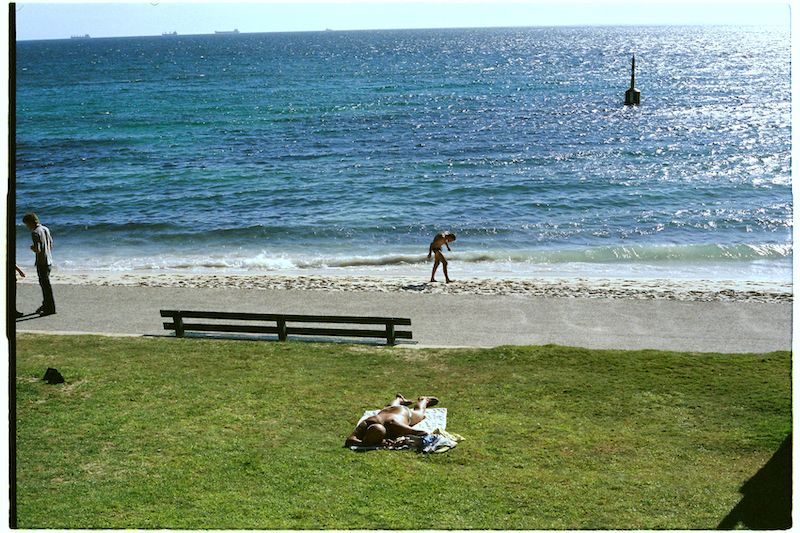
Chelsea Hopper, Cottesloe Beach 4, (Dead Tired series), 2011, inkjet print, 35.2 x 56.5cm.
Disclaimer: From Wakefulness to Consciousness
An impersonal abyss of unbounded collective potentiality Undisciplined The night relieves our thresholds We wake Consuming modular soundtracks
Online Journal
Disclaimer is a journal for new thinking and writing on listening and sound, published by Liquid Architecture.
This new edition From Wakefulness to Consciousness focuses on the politics, poetics and aesthetics of sleeplessness.
It extends an invitation to listen with insomnia, to open a space to listen in and through our bodies. Inspired by bodily rhythms and the pace of production, we have programmed a slow release in five parts - dissonance, collapse, release, awakening and respite - from November 2020 into January 2021.
This collection is edited by Paris based Associate Curator and Liquid Architecture Alumni, Anabelle Lacroix, and features contributions from artists, curators and researchers in both Europe and Australia: Mattin, Elena Biserna, Tobi Maier, Geoff Robinson, Clare Milledge, Tom Smith with Jon Watts, Zoe Scoglio, Tricky Walsh, Debris Facility Ltd Pty, Kengné Téguia, Holly Childs and Angela Goh, Pan Pan Kolektiva, Alexander Powers, Jannah Quill, Anne Zeitz and SJ Norman.
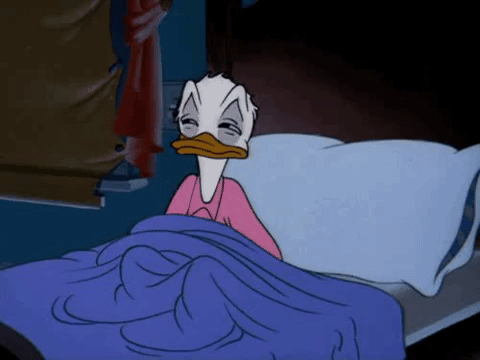
Image: Donald Duck in Early to Bed, 1941
Disclaimer est un journal de réflexion critique et d'écriture sur l'écoute et le son, publié par Liquid architecture.
From Wakefulness to Consciousness explore la politique, la poétique et l'esthétique de l'insomnie. Cette édition fait partie d’un projet curatorial plus large qui porte sur la désynchronisation entre les corps et la société, et une volonté de réinvestir la nuit et ses énergies, qu'elles soient naturelles, cosmiques, sonores ou autres.
C’est une invitation à écouter avec l’insomnie, pour ouvrir un espace d’écoute qui passe par notre corps entier. Inspiré par nos rythmes corporels, et en contre-point avec le rythme de production actuel, nous avons choisi de programmer cette édition en cinq parties : la dissonance, l’effondrement, la libération, le réveil et le répit, qui vont se déployer progressivement sur Disclaimer entre novembre 2020 à janvier 2021.
Cette collection est éditée par Anabelle Lacroix, curatrice associée de Liquid Architecture, basée à Paris. Elle rassemble des contributions d'artistes, de curateurs et de chercheurs en Europe et en Australie : Mattin, Elena Biserna, Tobi Maier, Geoff Robinson, Clare Milledge, Tom Smith avec Jon Watts, Zoe Scoglio, Tricky Walsh, Debris Facility Ltd Pty, Kengné Téguia, Holly Childs et Angela Goh, Pan Pan Kolektiva, Alexander Powers, Jannah Quill, Anne Zeitz et SJ Norman.
Freedom of Sleep : Nuit Blanche
Lancement
Radio Broadcast and Podcasts
Launch
Vous trouverez ici les enregistrements de Freedom of Sleep. Programmation complète sur la page de l'événement.
Pour ce premier temps fort, nous avons eu la volonté de rassembler le public avec une invitation pour repenser la nuit blanche et vivre un état d’éveil conscient et d’écoute active, autour de vidéos de Salma Cheddadi et Sonia Leber & David Chesworth, d’installations de Vivien Le Jeune Durhin, de performances et de live radio avec les performances de Dress rehearsals, Hanne Lippard, Amosphère, No3sis, m : f et Antoine Calvino.
Nous avions invité Stéphanie Jamet, historienne de l’art, et Arnaud Guery, musicien et directeur artistique du festival Les Sonifères pour une table ronde sur l’intersection entre d’art, de sommeil et d’écoute active.
Cet évènement a été réalisé en collaboration avec Threads*sub_ʇxǝʇ Radio et No3sis, avec la participation de Dj Sentimentemily, Nathan Gray, Alex Head & Shanti Suki Osman, Jan Peknik Kozák, Daniel Jenatsch, Giles Fielke, Michelle O’Higgins Theilmann.
La totalité des contenus audios sont disponibles sur la playlist ici :
You will find here recordings and documentation of Freedom of Sleep. Full program on the event page.
This first public forum gathered audiences with an invitation to rethink White Night, to experience a state of conscious awakening and active listening through the presentation of videos, installations, performances, and live radio with performances by Dress rehearsals, Hanne Lippard, Amosphere, No3sis, m: f and Antoine Calvino.
We invited Stéphanie Jamet, art historian, and Arnaud Guery, musician and artistic director of the festival Les Sonifères for a round table discussion on the intersection between art, sleep, and active listening.
This event was realized in collaboration with Threads*sub_ʇxǝʇ Radio and No3sis, with the participation of Dj Sentimentemily, Nathan Gray, Alex Head & Shanti Suki Osman, Jan Peknik Kozák, Daniel Jenatsch, Giles Fielke, Michelle O'Higgins Theilmann.
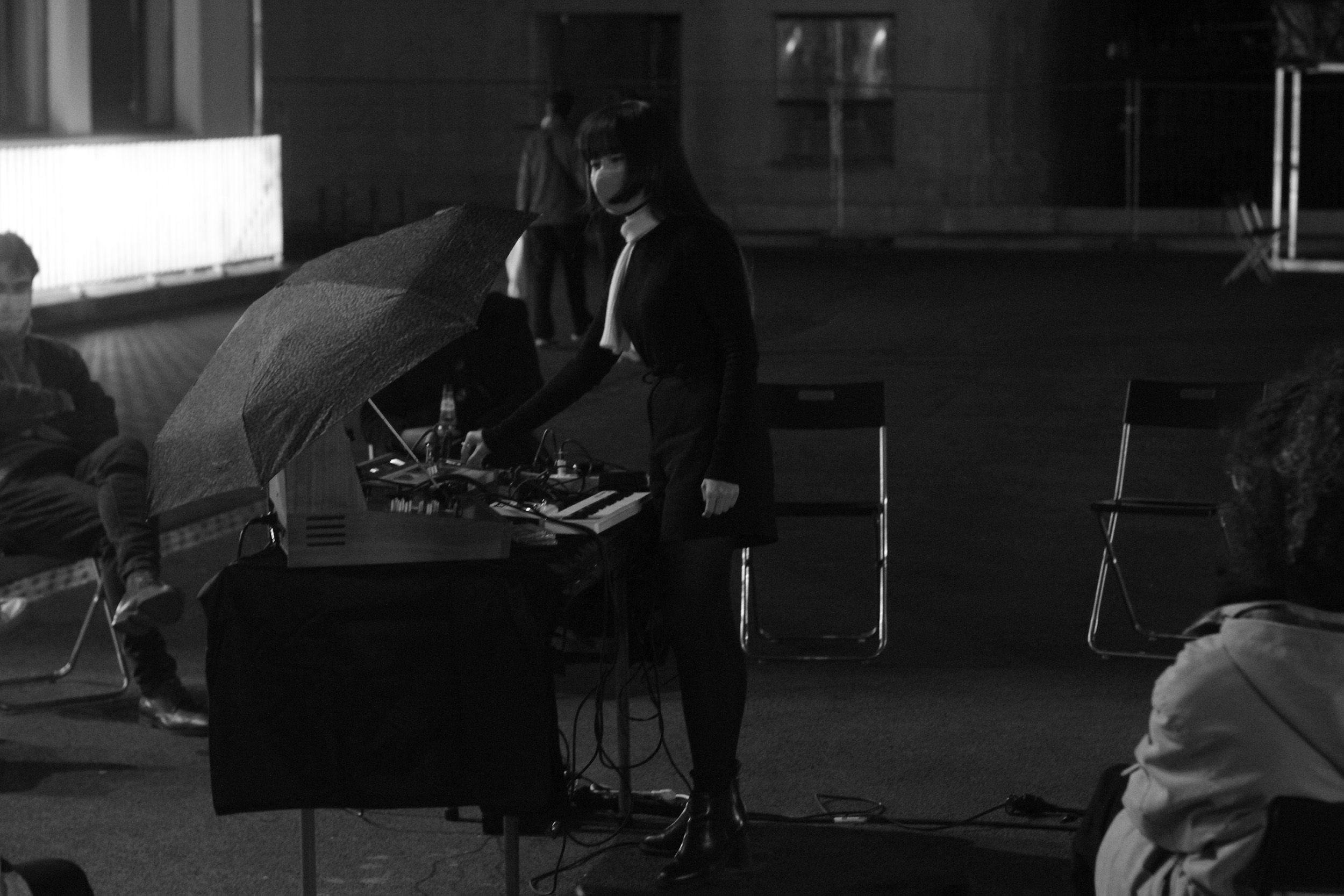

Amosphère

Antoine Calvino
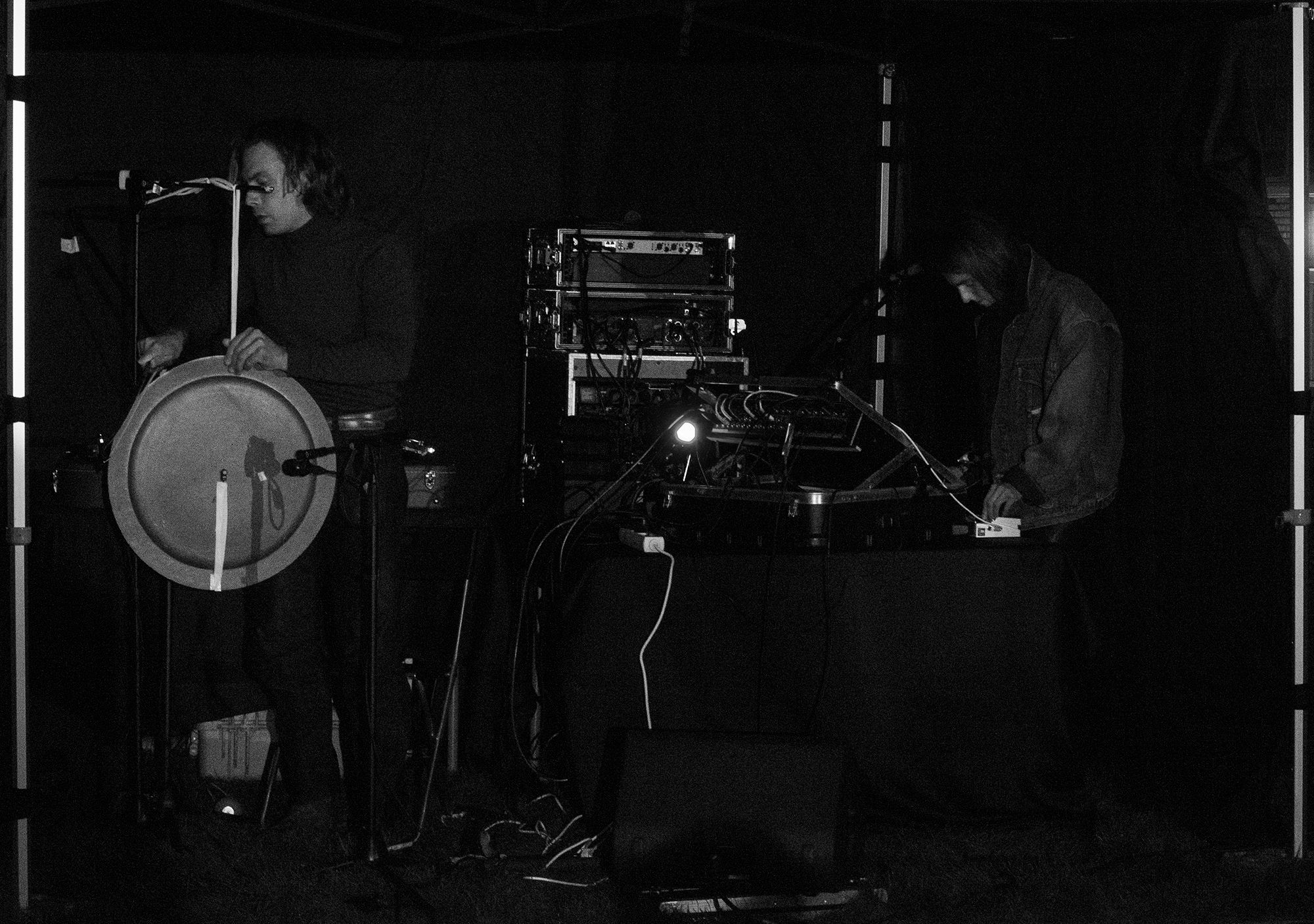
Dress Rehearsals

Hanne Lippard
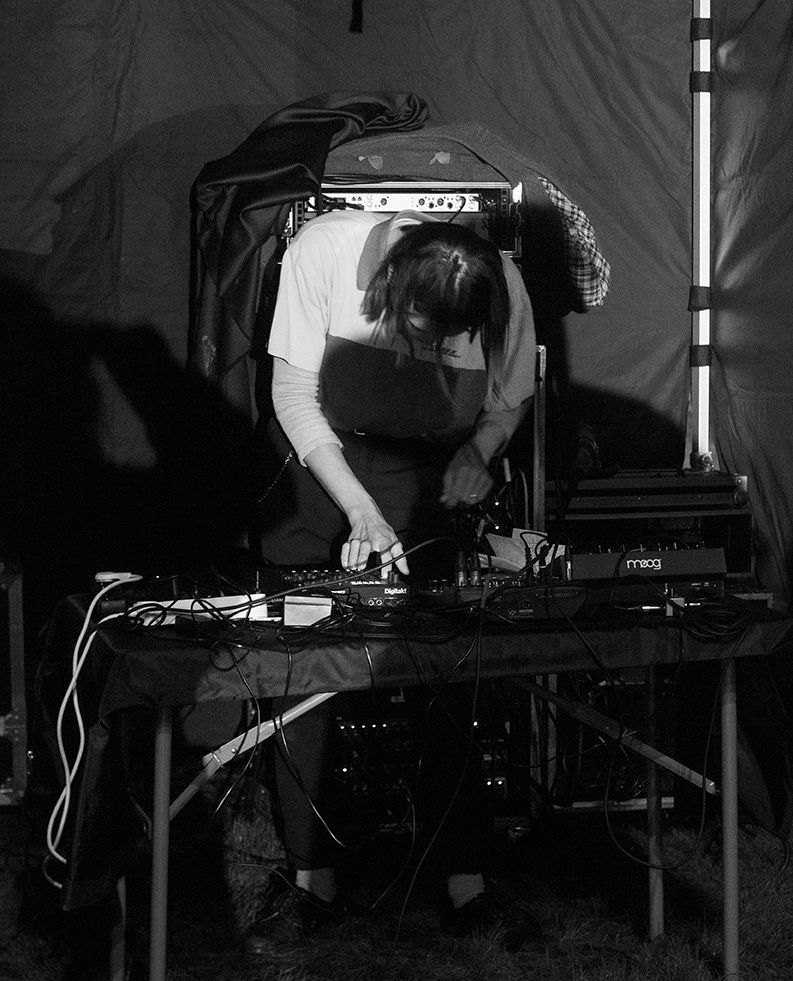
M : f
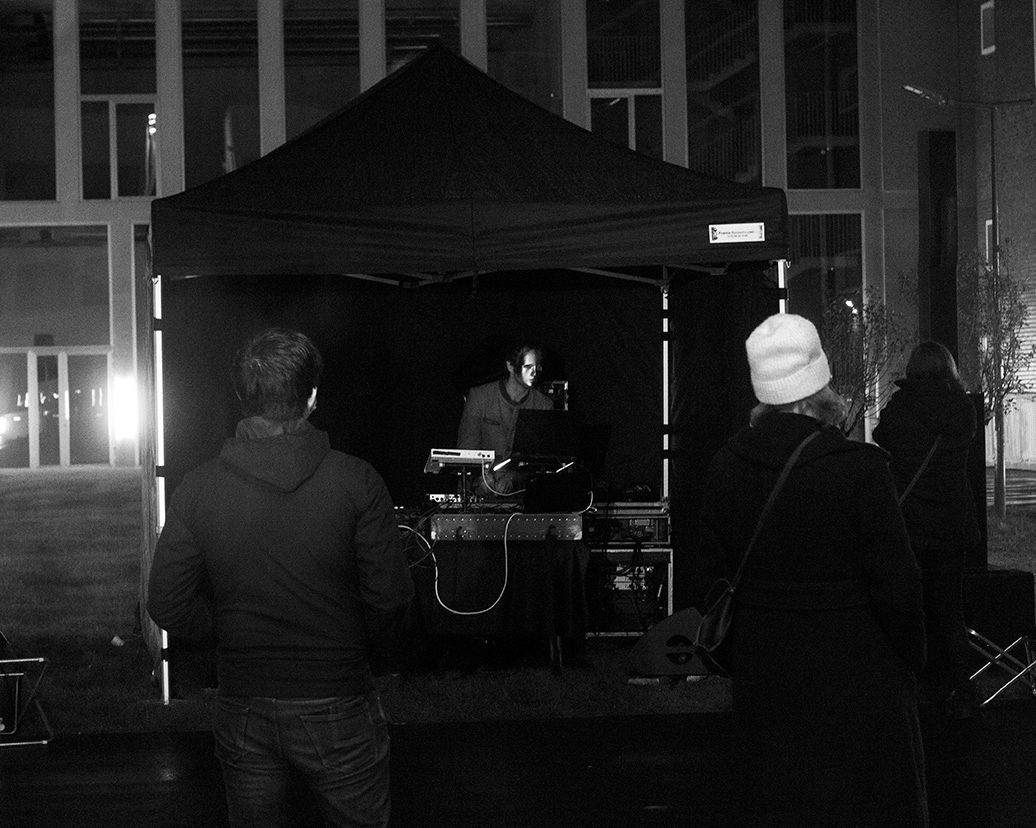
No3sis

Salma Cheddadi, Chasseur sachant chasser, 2012, 10mn, HD video
Collection d’art contemporain du département de la Seine Saint-Denis
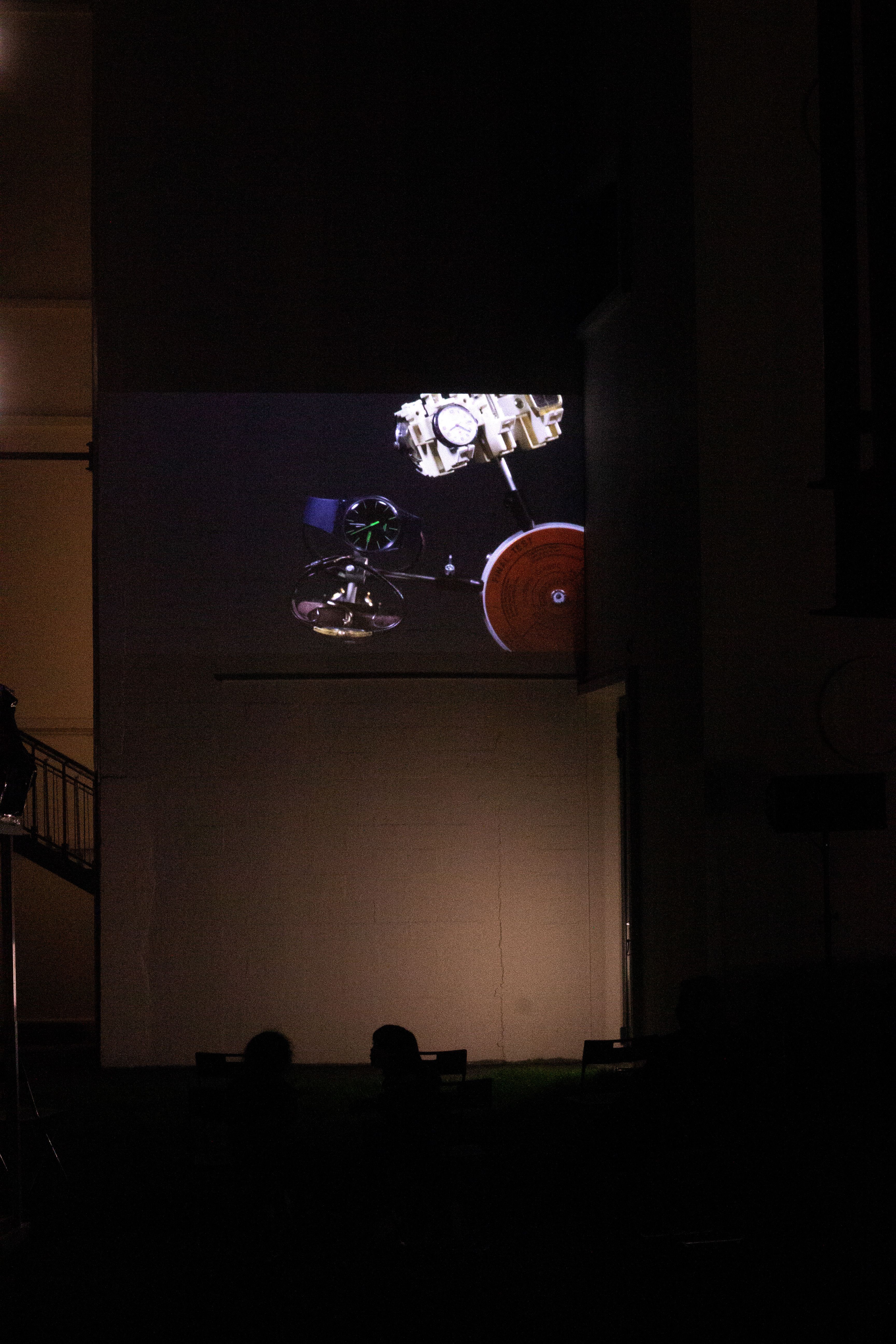
Sonia Leber & David Chesworth, Myriad Falls, 2017, HD video, stereo audio, 6:30’. Courtesy the artists.
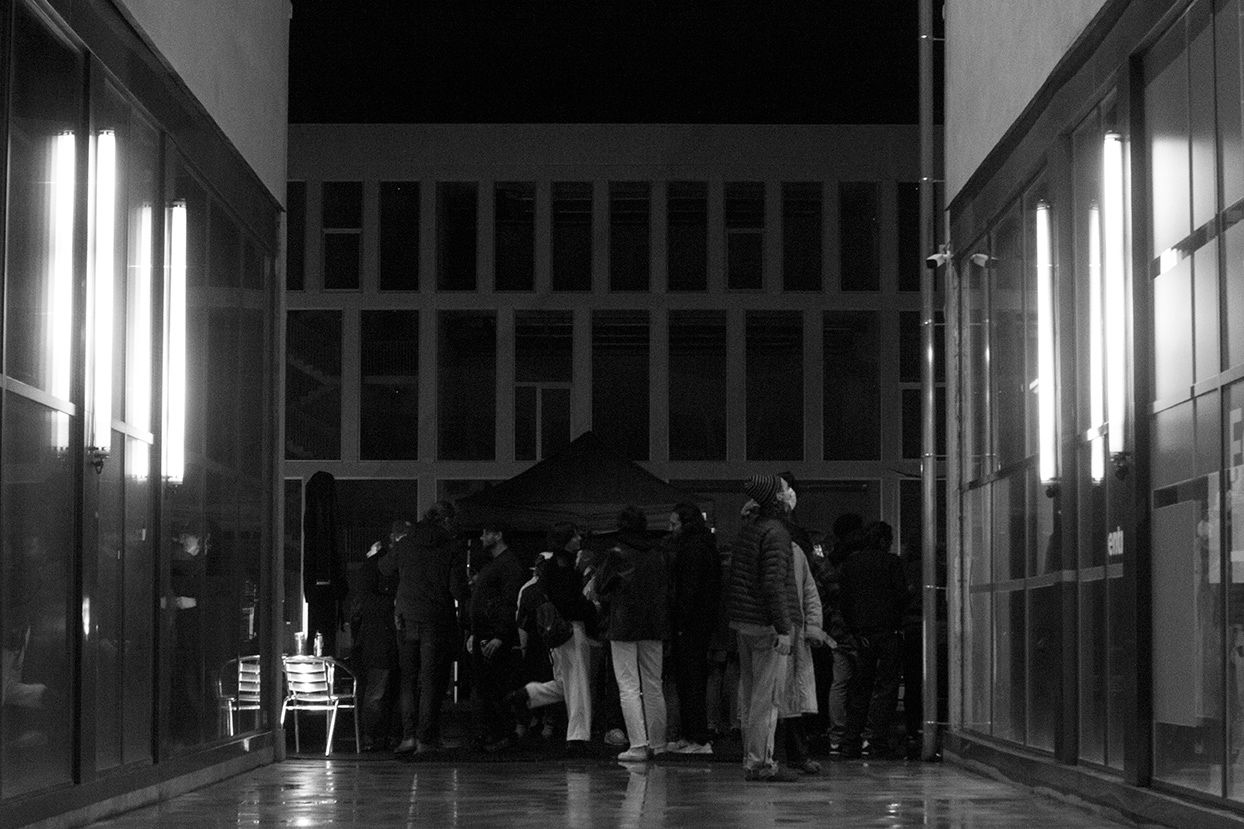
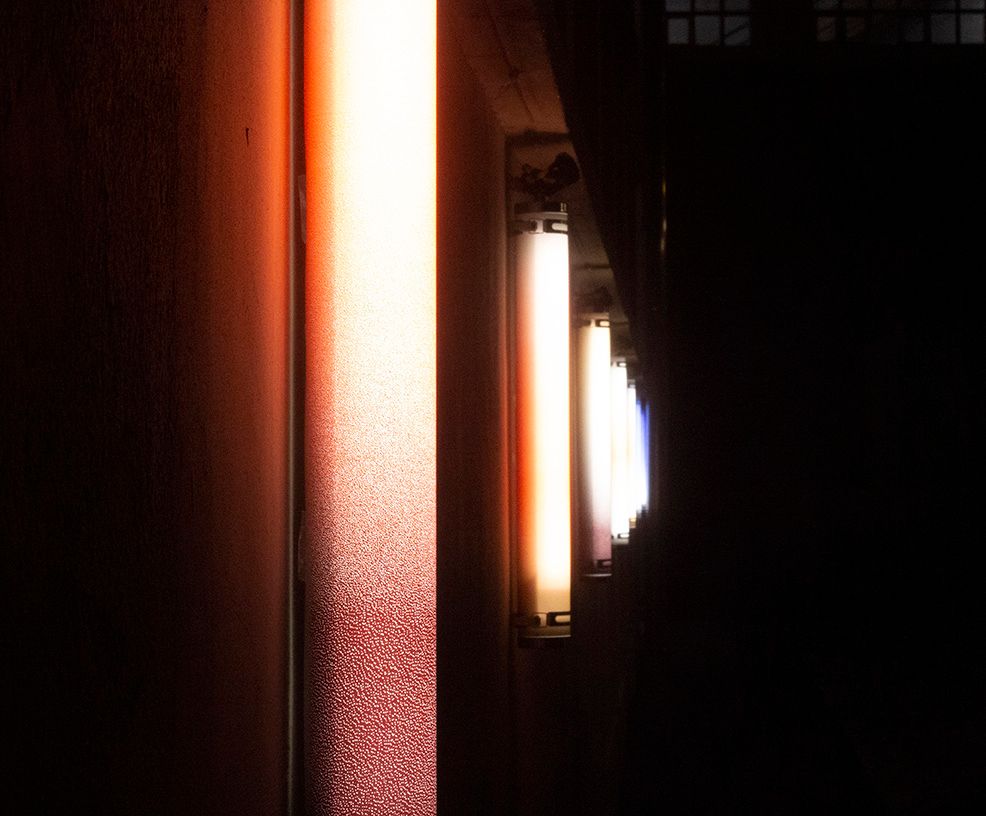

Vivien Le Jeune Durhin
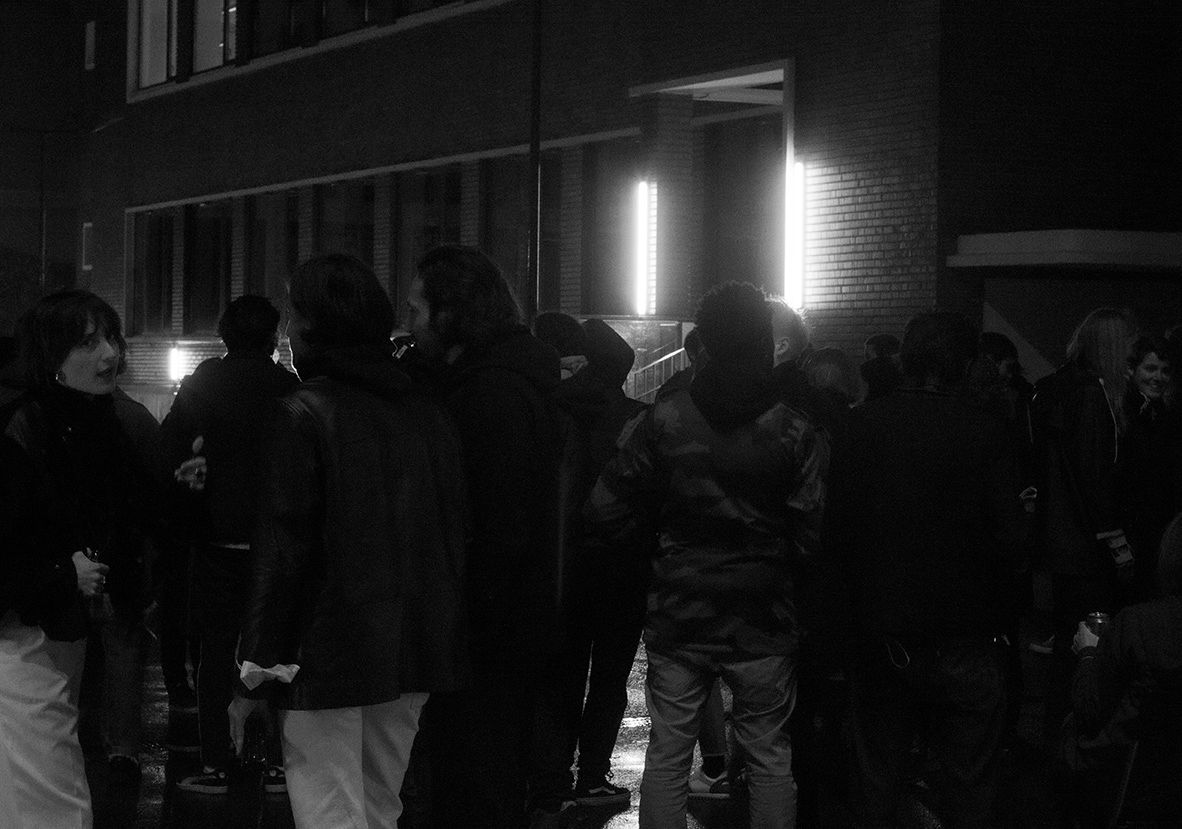
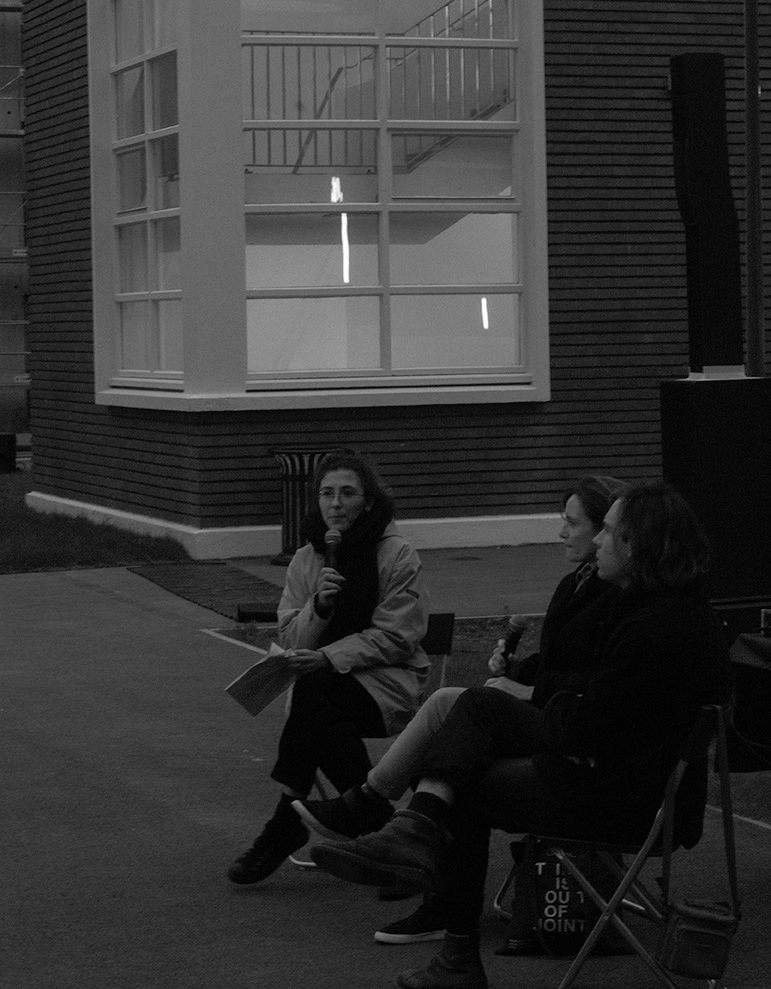
(Non)Sleep as Social Practice
Un programme radiophonique sur la dimension politique de l'insomnie, s'appuyant sur la désynchronisation entre le corps et la société, l'individu et le groupe. Présenté par Threads * sub_ʇxǝʇ radio et ZK/U Zentrum für Kunst und Urbanistik, et réalisé pendant le confinement.
Radio Broadcast and Podcasts
A broadcast on the politics of sleeplessness, desynchronization between the body and society, the individual and the group. Presented by Threads*sub_ʇxǝʇ radio and ZK/U Zentrum für Kunst und Urbanistik.
Ce programme contient des lectures, des interviews et des contributions d'artistes et musiciens. Pendant la durée d'une nuit, de 22h à 7h il vous fait naviguer à travers des cycles de «dissonances», de «relâchements» et de «réveils». Il a été réalisé en anglais.
ARTISTES ET CONTRIBUTEURS :
Pia Achternkamp aka. loh; Katja Aglert; Félicia Atkinson; Méryll Ampe;
Apocrypha | أبوكريفا; Critical Techno; David Clark: Nothing to See Here;
Danilo Correale; Dis Fig; Nathan Gray and The Weirding Module; Alex Head on Deviancy; Khalab feat Tenesha The Wordsmith; Grace Euna Kim & Biliana Voutchkova; Petra Klepcová; Josephine Mead; Jannah Quill; Geoff Robinson; Muhammad Salah; Gustavo Sanromán Vázquez, Shackleton; Anthea Caddy and Thembi Sodell; Byungseo Yoo
Work vs./& Abstraction + Feelings (at night):
Klara Ström; Vera Vice (Ave Vellesalu & Helen Västrik); Eero Pulkkinen & Eeva-Maija Pulkkinen; Ana Gutieszca; Vilja Vee (Niko Tiinanen); Nadine Byrne; Helena Pulkkinen & Saara Taipale and Frank Rizzo
The program investigates the potential for collective socialites to reclaim night time as a form of resistance against individualizing and homogenizing forces through sound and listening. For the duration of one’s night of sleep, the program features a range of international artists, experimental musicians and radio makers, and navigates through cycles of ‘dissonances’, ‘releases’ and ‘awakenings’.
DISSONANCE #1: (NON)SLEEP AS COLLECTIVE, AND SOCIAL PRACTICE
An introduction to this program that will explore structures of time and control, movements of falling and rising. Sleep is a point of amplification for other fears and anxieties in contemporary times. We suggest that sleeping is a social and cultural practice that can be used to rethink relationships between our bodies and society, between individuals and groups. In this time of social isolation, we open this first movement with a sound piece that connects localities and times through the sounds we hear upon waking and falling asleep.
RELEASE #1: FALLING: DECONSTRUCTIONS OF THE MIND AND TIME
In this section, the composition by Biliana Voutchkova (which was part of a performance piece by Grace Euna Kim) slowly unfolds as a sonic tool to deconstruct psychological structures imposed by society’s normalized systems that are embedded in our bodies. Perception of time itself is questioned as form of pressure upon strict periods of sleep and wakefulness. Méryll Ampe’s new release ‘Residues of Time’ played here and throughout the program was composed over a year, in exploring durational processes and working with residues of sound materials.
AWAKENING #1: POLITICAL AWAKENINGS: ON UPRISINGS AND DE-
COLONISATION
Sleeping and being awake are both revolutionary acts. With his section we look at this long tradition through Anna Della Subin’s book “Not Dead but Sleeping” and a speech by Martin Luther King. Awakening is a common metaphor for political movements and uprisings, particularly in relation to de-colonisation. We discuss Achile Membe’s idea of ‘coming out of dark night’ in a French context, and are also transported to the streets of Khartoum during the Sudanese Revolution last year with tracks composed by the collective Apocrypha.
RELEASE #2: COLLAPSE
The final release: collapse. A focus on Grace Euna Kim’s research into the psychic life of ideology, and the body as a site of resistance in crisis.
DISSONANCE #2: SLEEP, COGNITIVE CAPITALISM AND BIO-CAPITAL: ON CONTROL AND NORMALISATION, ANXIETY, SILENCING AND DEVIANT KNOWLEDGE
In these early hours of the morning you are invited to find periods of rest to explore the porous states that lay between sleep and unsleep with talks and experimental music. During an interview with Alex Head we discuss deviant knowledge, entropy and forms of othering, and with Gustavo Sanromán Vázquez we unpack ideas of cognitive capitalism, and the current cultural shift in brain hacking and the pharmakon. Subliminal messaging and sleep
programming for self-performance and healing is also explored by Nathan Gray. Through sound we experience speed, attunement and empowerment. We focus on the body, on listening in, with and through our bodies, and think about anxiety as an alarm bell to take action.
AWAKENING 2: DAWN, TRANSITIONS & NEW COSMOLOGIES: MULTI-LEVEL AND QUEER LISTENING
This last movement deals with binaries, the binaries of day and night —and other integrated binaries— through a process of slow transformation and transition. We focus on what we are not used to listen to, as well as thinking about other forms of listening to normalised listening. We explore feminist, queer and multi-level listening with a reading from Gloria Anzaldúa and Work vs./& Abstraction + Feelings (at night), cosmic listening with David Clark as well as alien listening with sounds from the deep past. At the end of the program, Danilo Correale prepares us for a post-work society and indirectly reflects the role of art in the specific times that we live in.
sub_ʇxǝʇ is an itinerant platform for research, discussion and sonic knowledge production. It produces and distributes radio programmes across a thematic spectrum ranging from investigative reporting to experimental sound and music. Threads*sub_ʇxǝʇ is the sister-studio of Threads Radio (London) based at ZK/U and elsewhere in Berlin, Germany. It builds on the dynamic interconnectivity of the ZK/U echoing its drive towards meaning-creation and disruption in the urban sphere.